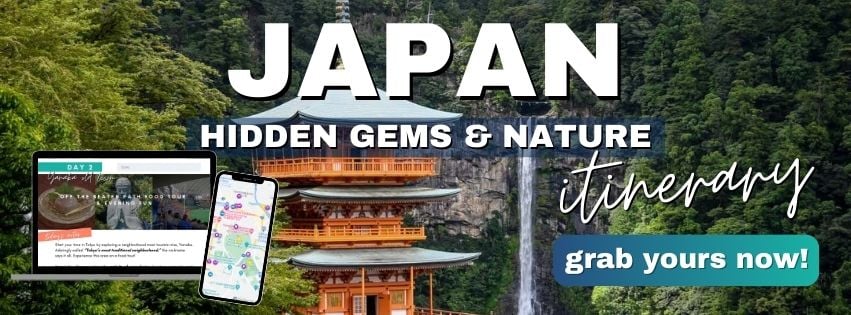Hiking the Nakasendo Trail is one of the best experiences you can add to your Japan itinerary. This guide will help you plan your visit so you can experience this hidden gem in Japan for yourself.
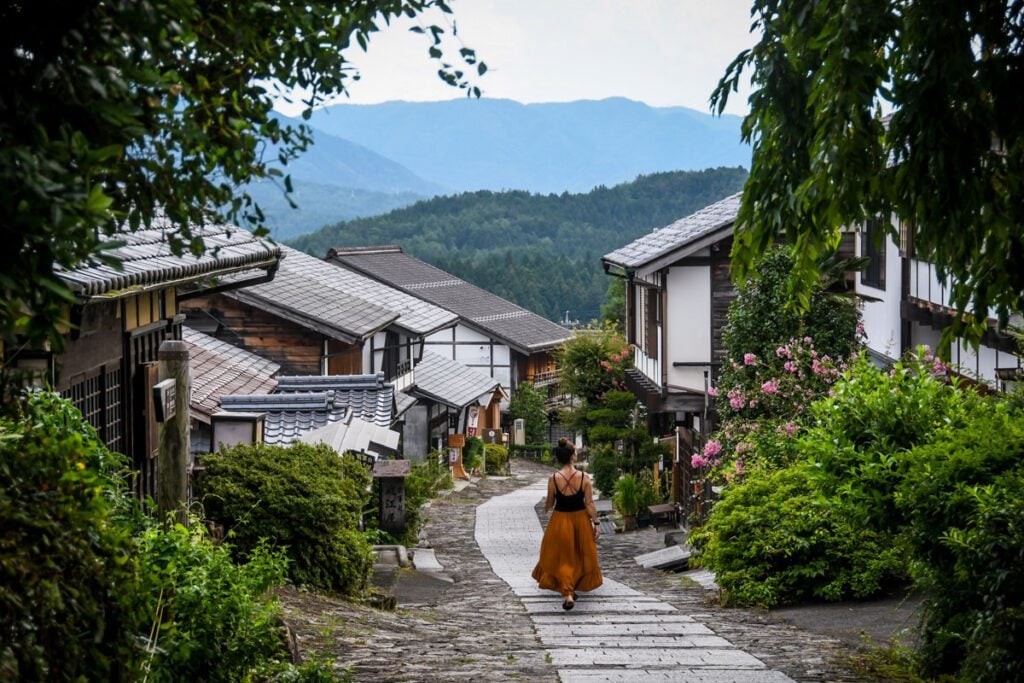
Nestled in the rural countryside of Nagano, the Nakasendo Trail is a historic path where you can walk the exact footsteps of merchants, samurai, monks, and travelers who journeyed from Tokyo to Kyoto during the Edo Period.
Don’t worry—I’m not suggesting you walk all the way from Tokyo to Kyoto.
There’s a short section of the trail that has been preserved between two small towns, making for a pretty easy day hike that’s accessible to people of many ages and abilities.
That said, the logistics of hiking the Nakasendo Trail require a bit of planning.
We’ve hiked the trail twice and had two very different, but equally wonderful experiences. It is without a doubt one of our favorite things to do in Japan.
We’ve created this guide to help you plan your visit so you can add this incredible experience to your Japan itinerary.
Nakasendo Trail Guide
- Our experience
- Overview
- History
- Best time to hike
- Best stops along the trail
- Itinerary
- What to pack
- How to get there
- Where to stay
- Where to eat
- FAQs
- Japan travel resources
Our experience
In case you’re more of an audio/visual person, we made our experience on the Nakasendo Trail into a vlog-style video.
We’ve walked the Nakasendo Trail twice:
- August 2019: the two of us walked the trail in the sultry summer heat
- November 2023: we walked the trail with our daughter, who was just under 2 years old at the time
Both experiences were amazing; however, we do have a preference regarding season, so keep reading…
About the trail
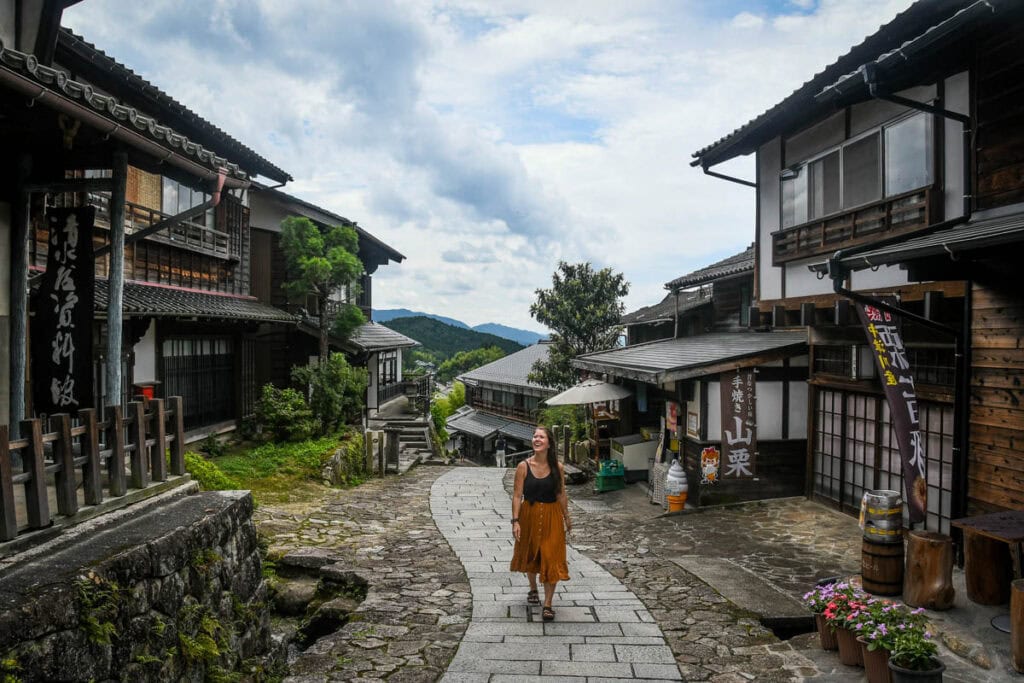
The Nakasendō Trail is an ancient route dating back to the Edo Period. Its name translates literally to “pathway through the mountains” and weaves through rural post towns and scenic countryside.
While modern development has taken over many portions of the trail, there are still a few sections that remain more or less in their original form. One of the most popular sections is in the Kiso Valley, between Magome and Tsumago, where you will experience the true essence and culture of Japan.
- Starting point: Magome
- Ending point: Tsumago
- Distance: 4.1 miles (8 km)
- Elevation gain: 800 feet
- Type of trail: point-to-point
- Difficulty: easy
- Timing: 2-3 hours
- View on AllTrails
History of the Nakasendo Trail
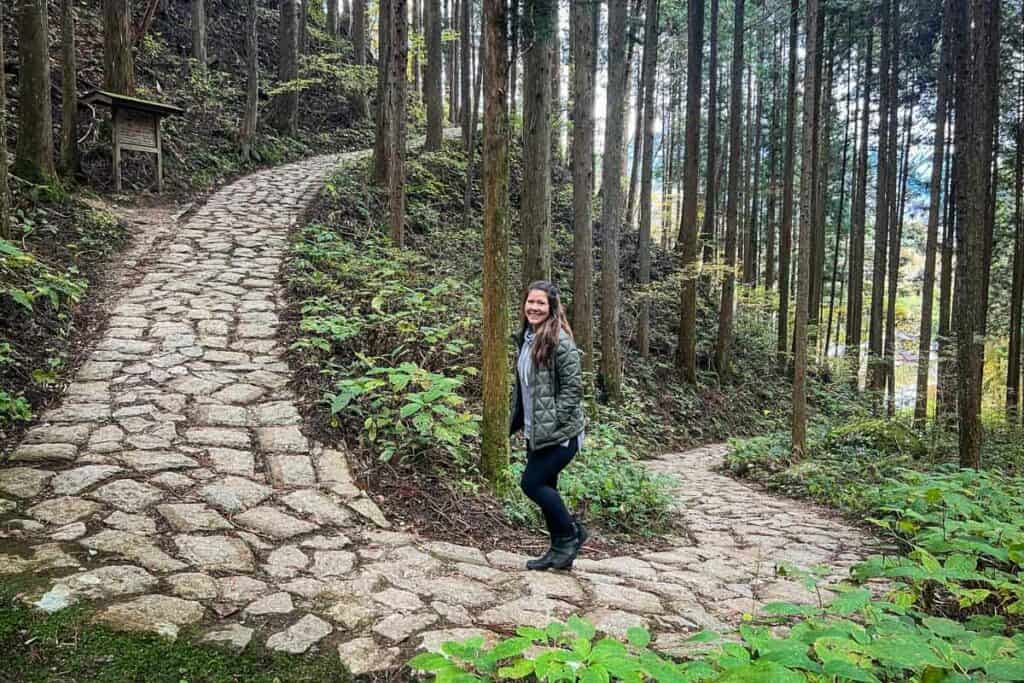
The Nakasendō Trail was one of 5 major roads known as Gokaido that connected Japan’s important cities during the Edo period (1603-1868). Nakasendō spanned more than 330 miles to link Kyoto and Edo (present-day Tokyo).
Gokaido were used by merchants, monks, samurai, and travelers to transport goods, messages, and people between major cities. Post-towns were built along the routes to provide lodging, food, and supplies for travelers, in addition to making up the postal service.
Tsumago and Magome were the 42nd and 43rd (respectively) of 69 post towns on the route from Edo to Kyoto. Due to their remote location in the Kiso Valley, these towns managed to avoid much modernization.
To this day, the lush forests, crystal-clear streams, and historic villages of this section of the trail remain preserved nearly in their original form.
Best time to hike the Nakasendo Trail
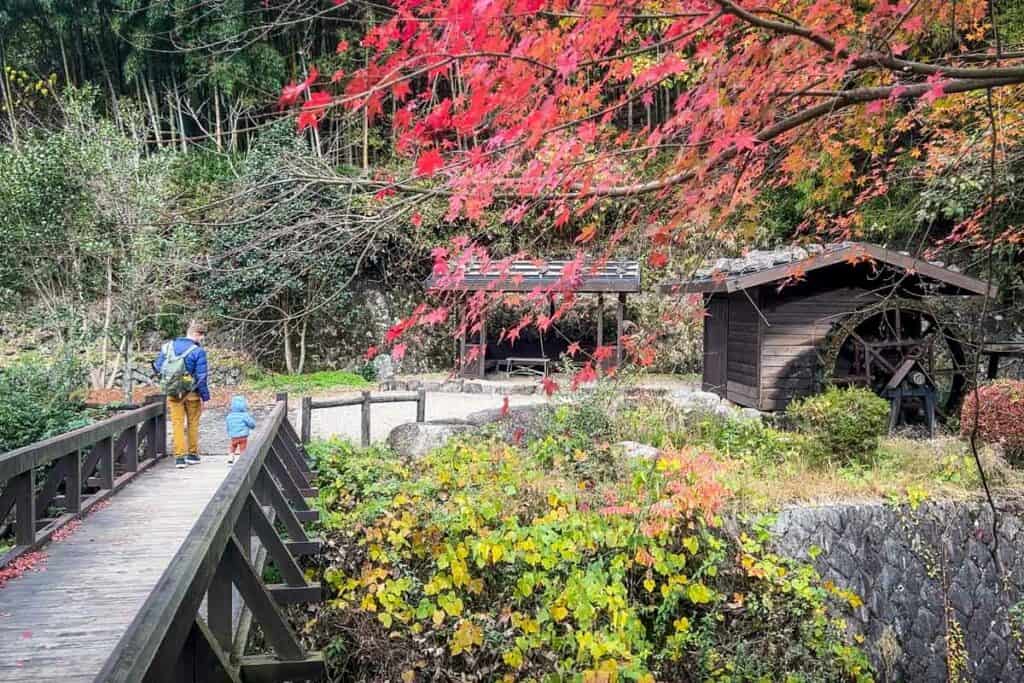
While you can hike the Nakasendo Trail all year long, the best time is undoubtedly during the fall.
The temperatures are comfortable and you get to enjoy the lovely fall foliage. Even though it was the perfect hiking conditions when we visited in November, we saw very few other people and had the trail to ourselves for the majority of the time.
We share all the details on regional weather patterns and temperatures in our guide to the best time to visit Japan, but here’s a brief description of what to expect on the Nakasendo Trail during each season:
Spring
If you’re visiting Japan in spring, hiking the Nakasendo Trail could be a good activity to add to your itinerary. This is not a hot spot for cherry blossoms, so visiting could give you some respite from springtime’s massive tourist crowds.
Summer
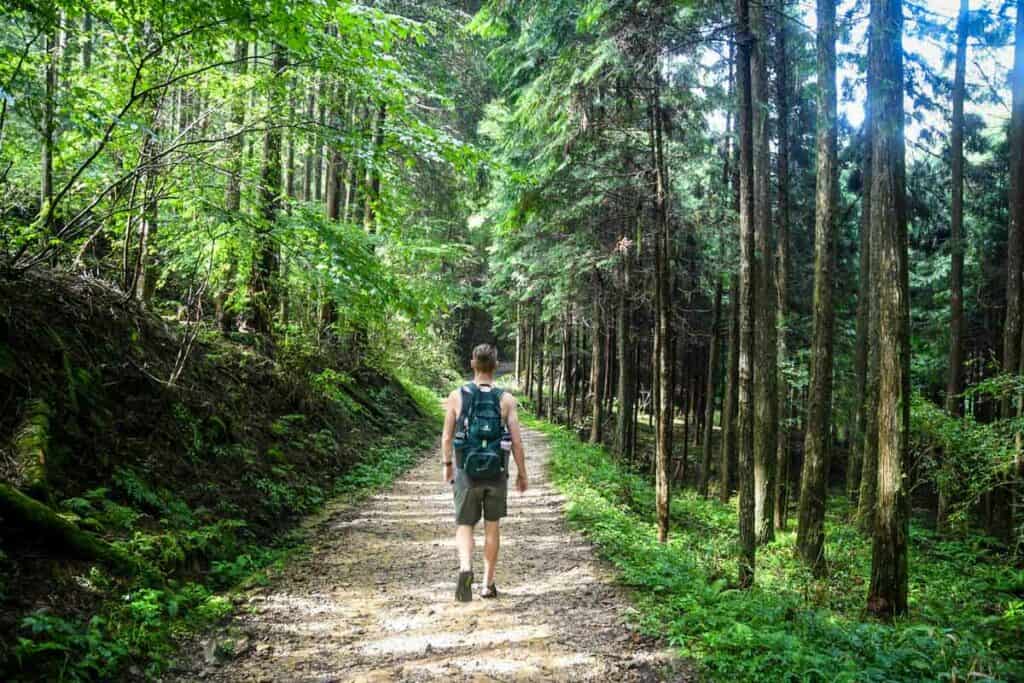
The first time we hiked the Nakasendo Trail was in August. While we had a great time and the lush green forests are undeniably beautiful, summer wouldn’t be my top pick…
Summer in Japan brings oppressive humidity, which isn’t ideal for hiking. You’ll also have a greater chance of encountering heavy rains and typhoons in the summer months (like we did!).
Fall
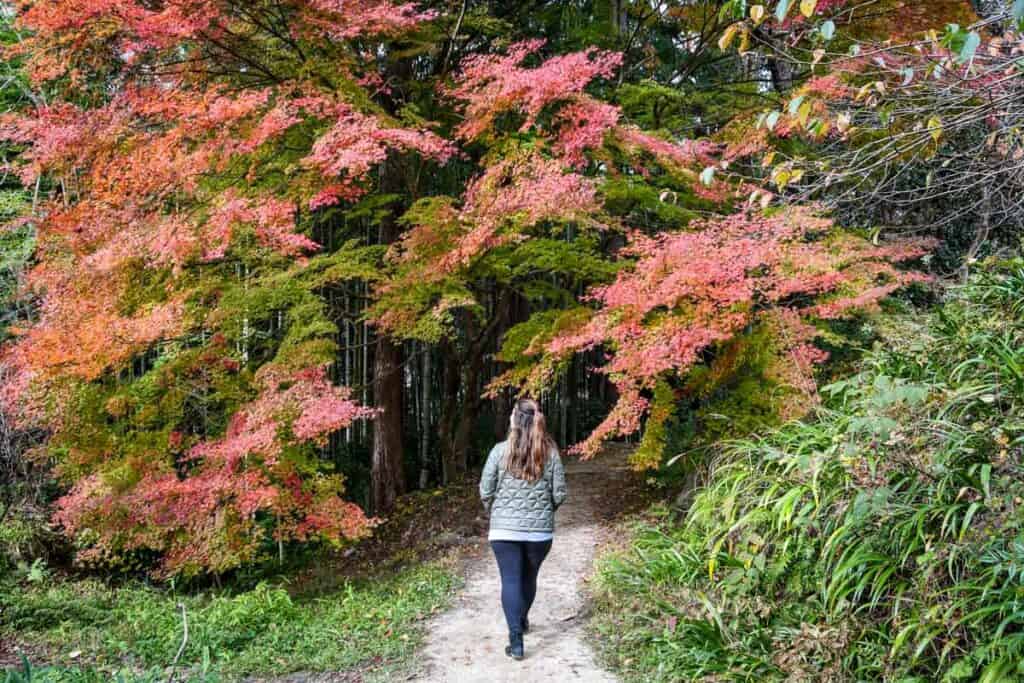
We walked the Nakasendo Trail in autumn in 2023 and it was absolutely perfect. Japan’s famous fall foliage was on display along the route and the weather and temperatures were ideal for hiking.
Despite the perfect conditions, we actually saw very few other people on the trail and even had it all to ourselves at times!
Winter
Winter in Japan is stunning and frankly underrated. You likely won’t encounter many other people on the trail in the winter months.
That said, snow and ice could make it harder to walk the trail or even get to Magome, so aim for December or late February if you want to plan a winter visit. Winter also means shorter daylight hours, so keep that in mind as you plan your day.
What to expect on the Nakasendo Trail
Read through the descriptions below to preview some highlights of the Nakasendo Trail. Or, if you want to see what hiking the trail is actually like, jump here to watch our video!
Magome
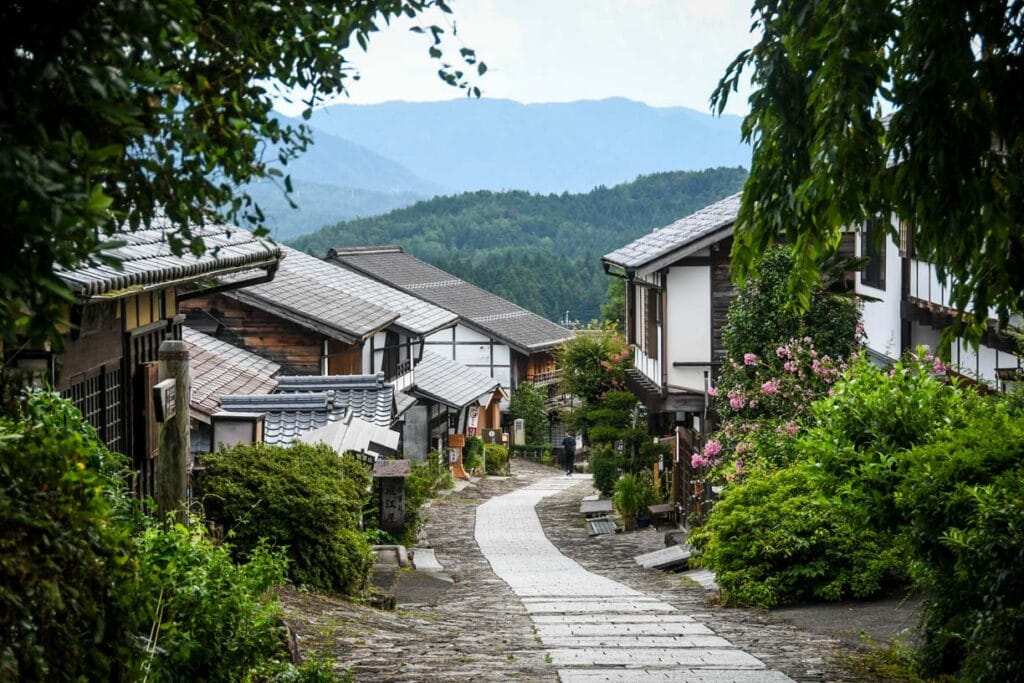
This historic town is the starting (or ending) point of the best-preserved section of the Nakasendo Trail, and is the perfect place to base yourself for the night.
The picturesque main street is lined with traditional homes, along with a few inns, cafes, and souvenir shops.
In our opinion, exploring a bit in the evening after you arrive and walking through town as you set off on your hike is enough to experience Magome. But if you have extra time, here are a few more places to check out:
- Ochiai Sunset Lookout Point: nice view overlooking the town with serene rice fields in the foreground and a backdrop of mountains
- Ochiai Cobblestone Path: preserved section of the original cobbled road
- Good to know: I would only consider including the Ochiai cobblestone path and sunset lookout point in your itinerary if you have a rental car. Though only a 7-minute drive from Magome, it takes nearly an hour to get there by bus, which probably isn’t worth it since you will see a similar (even better) cobblestone path later on the trail.
- Magome Post Town West Pond: scenic pond with a walking path around it
Owaki’s garden
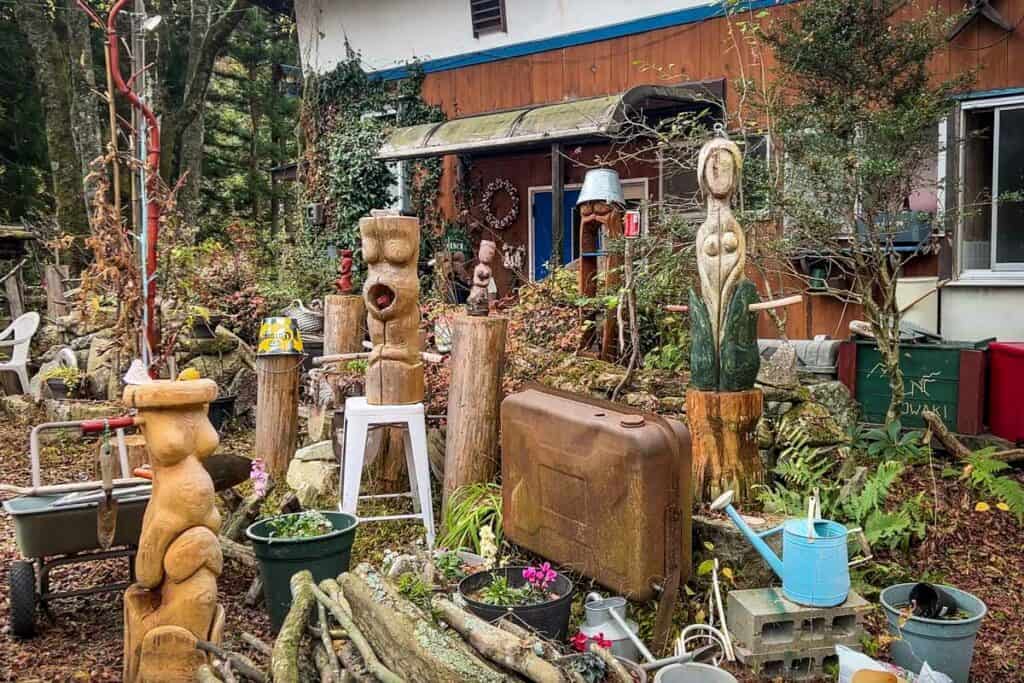
This quirky garden is one of the most unique highlights of walking the Nakasendo Trail.
In 1998, local resident Mr. Owaki opened up his garden for hikers to pass through on their way from Magome to Tsumago. The sign at the entrance declares “Free Garden, U may go through to Tsumago juku, I have no responsibility for your disappoint.” But I don’t think you’ll be disappointed…
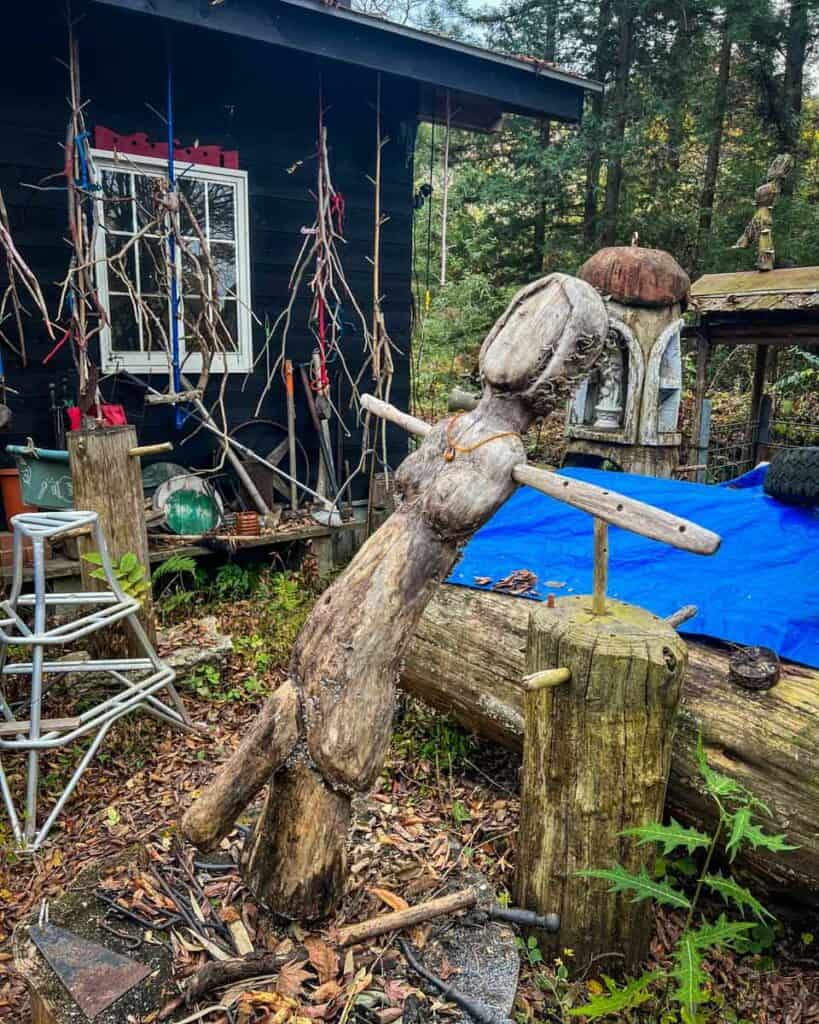
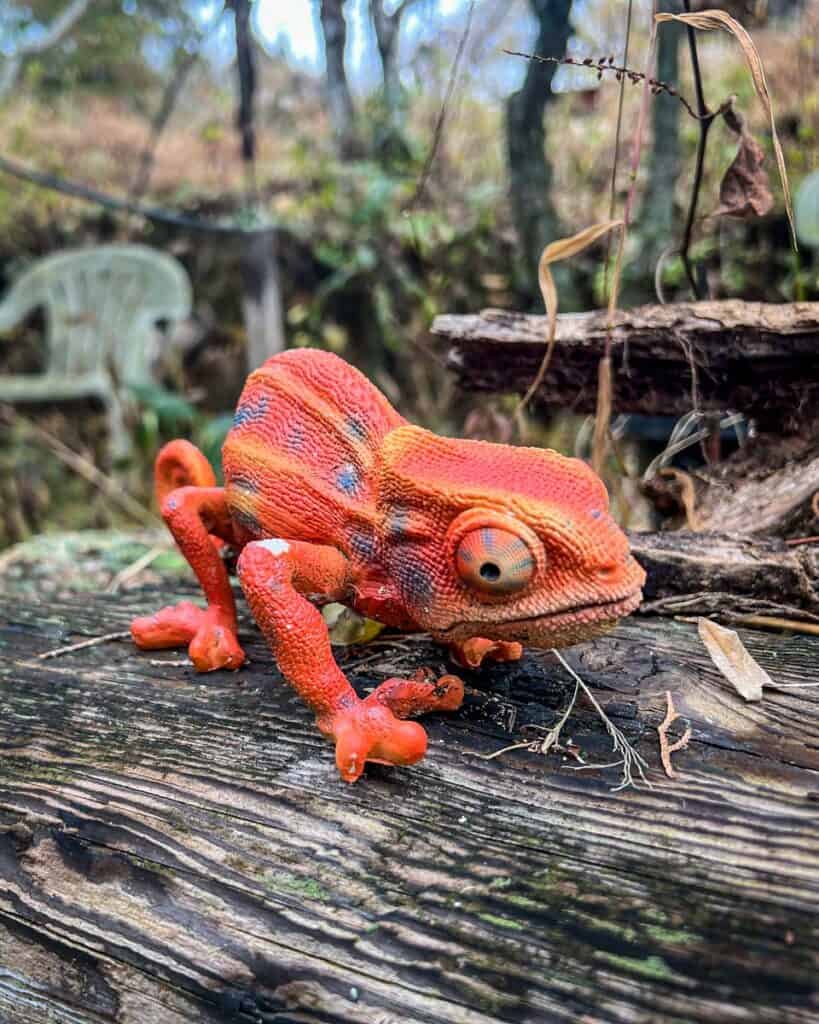
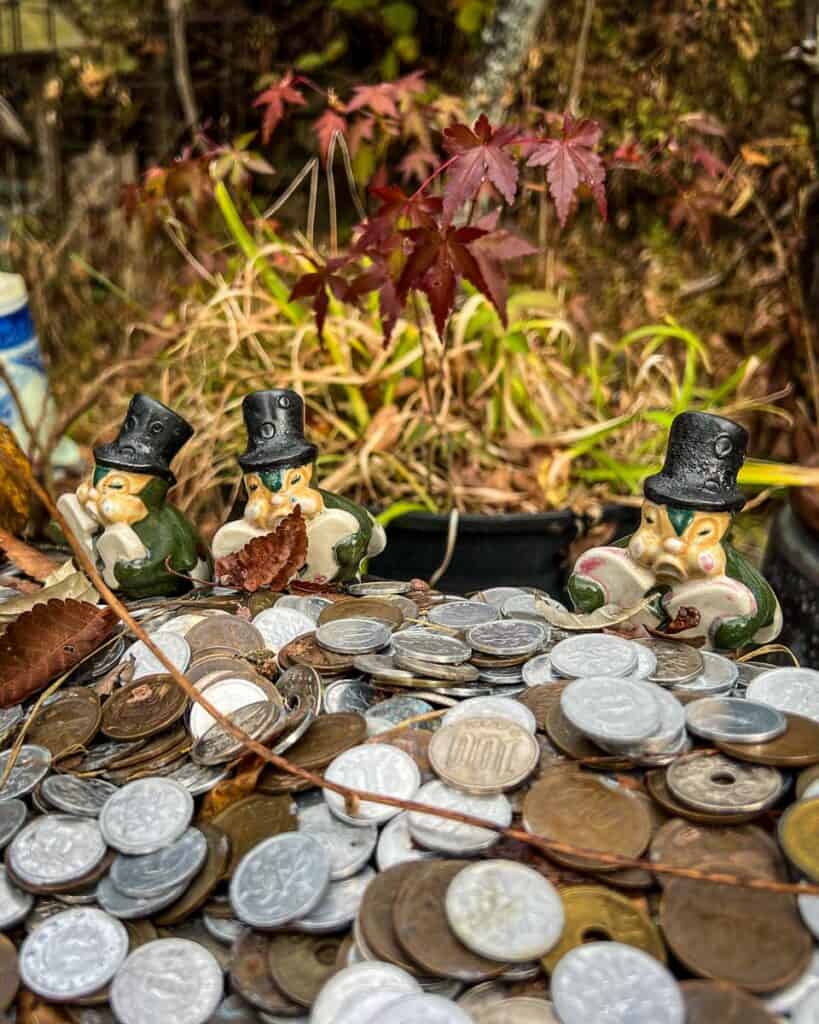
Exploring Owaki’s garden is like stepping into an I Spy book (who else remembers those?!). The property is strewn with figurines, sculptures, wood carvings, flowers, and more cheeky signage, including “U may look in but nothing special”, and “U may come in, I’ll never attack u, I am gentle”.
Make sure you keep an eye on the time; it would be easy to lose track while photographing the garden!
Magome Pass
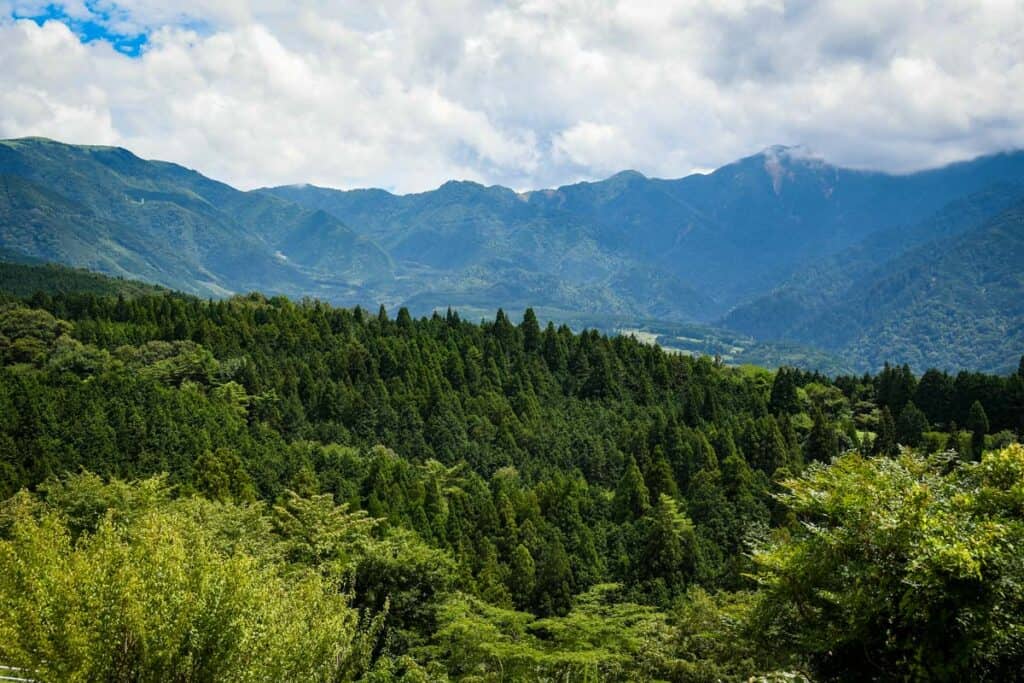
Magome Pass is located nearly a third of the way into the hike and is the highest point on the trail.
There’s a shop here that sells shave ice in the summer, which was a refreshing treat when we walked the trail in August 2019.
Look for signs indicating the Nakasendo Lucky Point, which is 777 meters above sea level.
Fun fact: In ancient times, Magome Pass was quite dangerous, but it has actually been lowered several dozen meters since the beginning of the Showa Era.
Teahouse
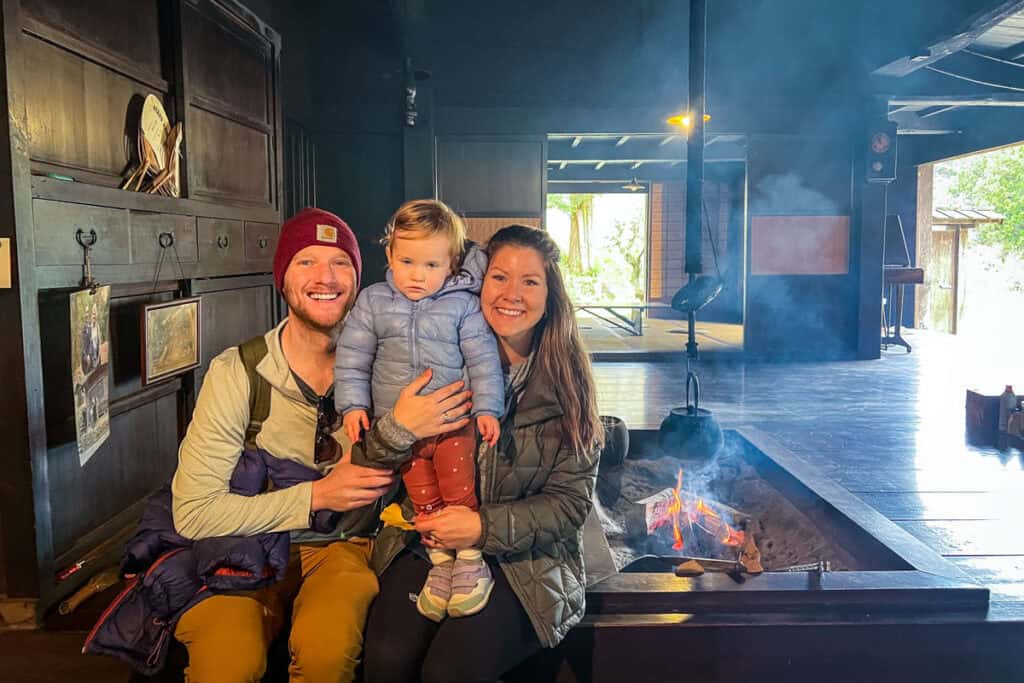
Marking the halfway point of the hike, this charming teahouse run by a sweet Japanese man is the perfect rest stop.
The teahouse is free to use, with self-serve green tea and hard candies available by donation.
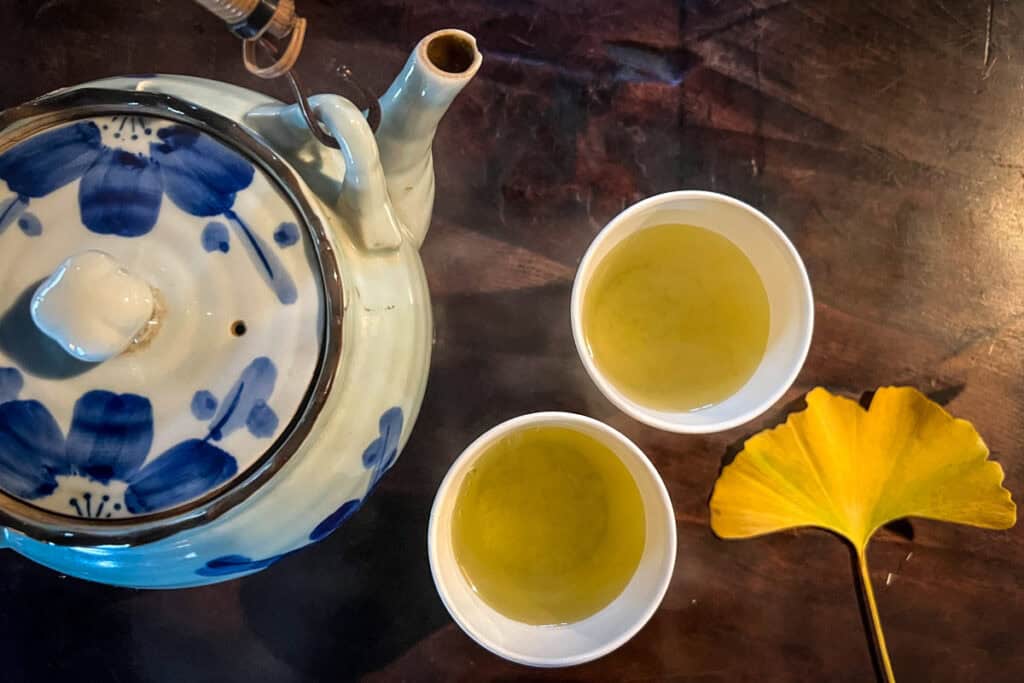


There’s a seating area as well as a traditional hearth, which creates a cozy atmosphere in which to enjoy a cuppa before continuing on the trail. Don’t forget to sign the guestbook and add your country of origin to the chalkboard outside!
Heads up! The toilets outside the teahouse are the only public restrooms on the trail between Magome and Tsumago, so make sure you go while you’re here.
Waterfalls
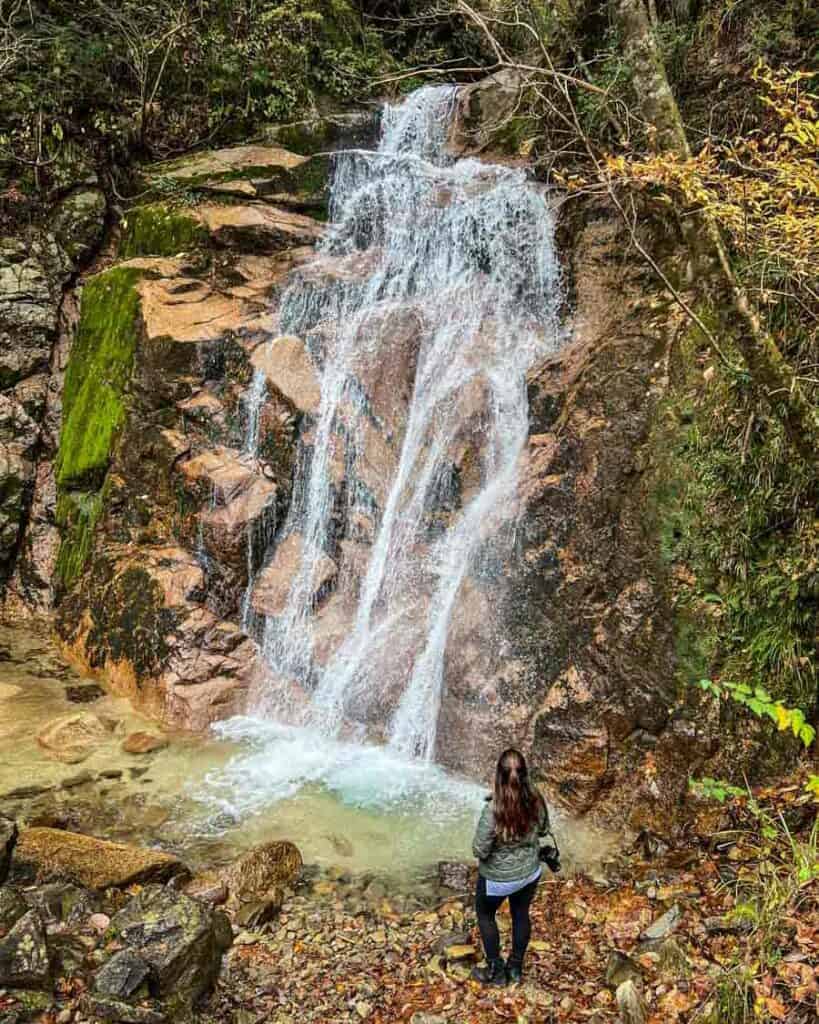
There are 2 cascades along this section of the Nakasendo Trail, known as “male and female” waterfalls.
Otaki Falls (male) is on the left and is the taller and broader of the two. Metaki Falls (female) is on the right. Depending on the weather and time of year you visit, it may appear as only a single, narrow chute.
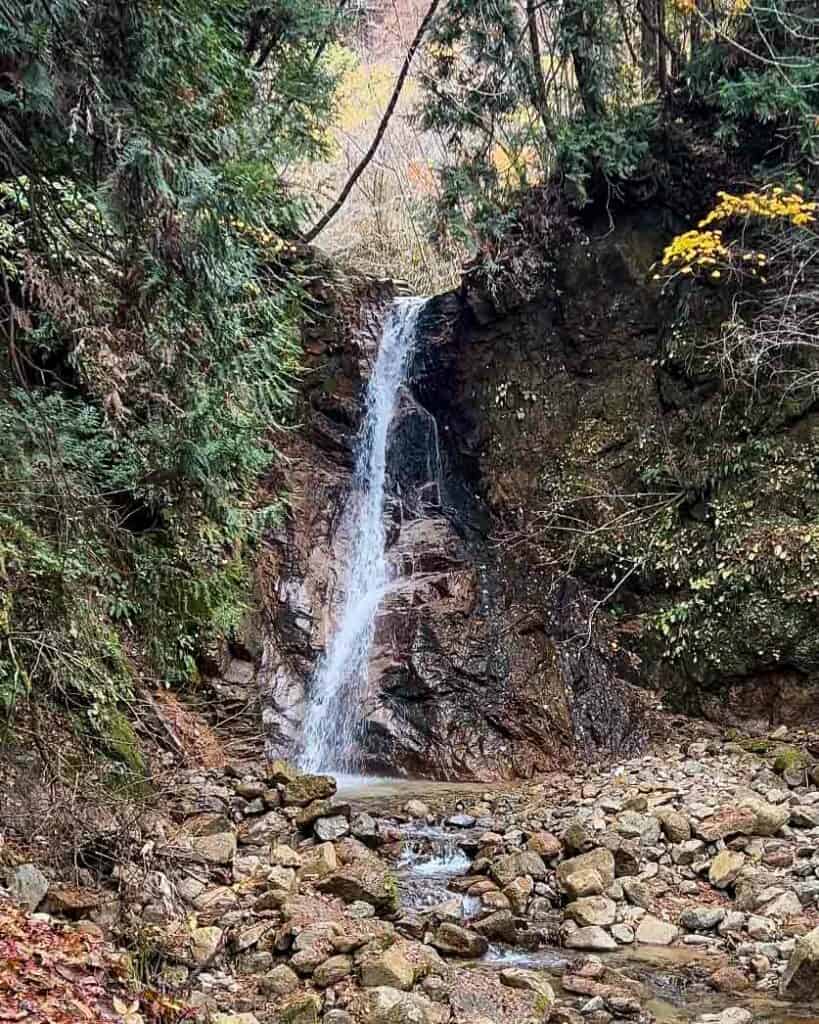
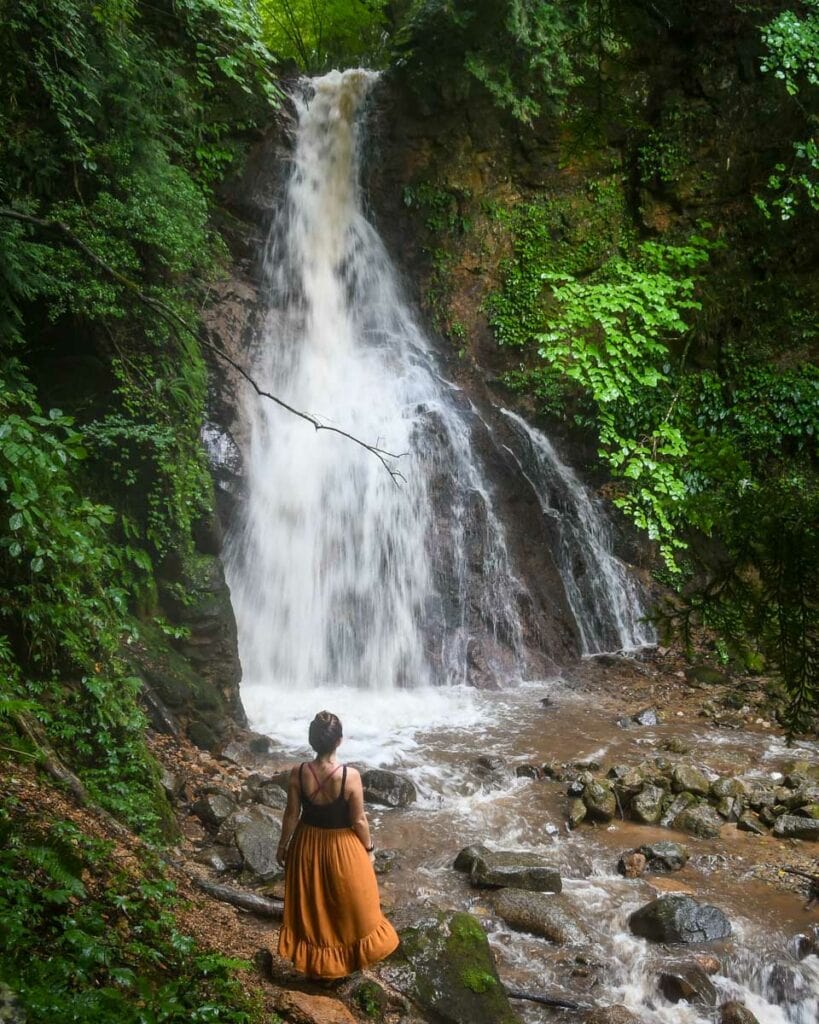
The waterfalls are pretty and worthy of a few photos, but you don’t need to spend a ton of time here.
Rural villages & farms
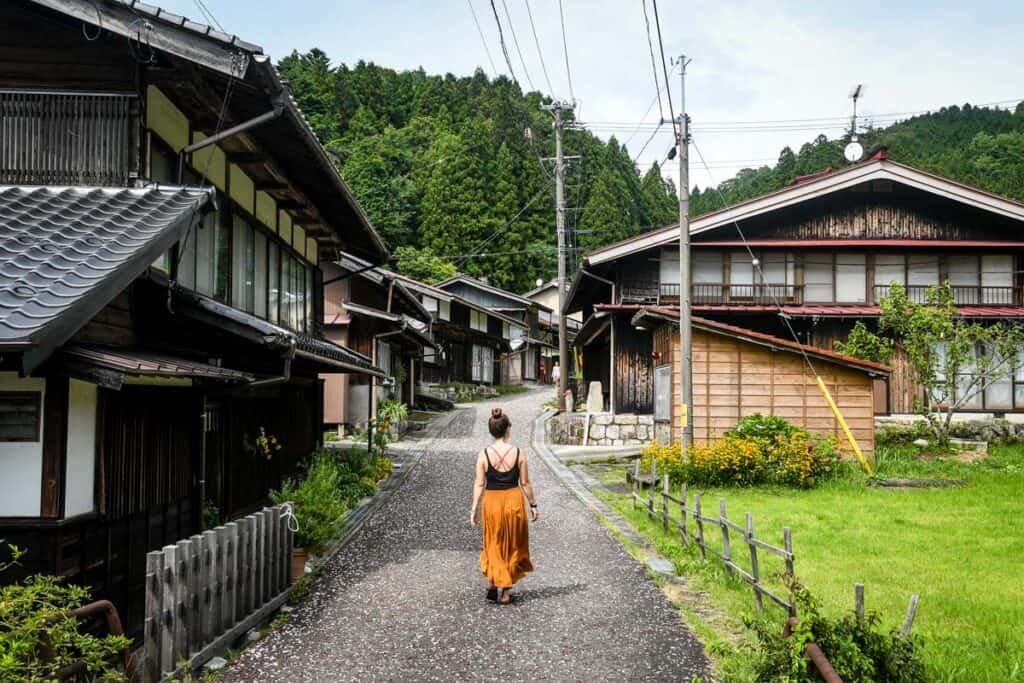
One of the coolest things about the Nakasendo Trail is that you get to see a completely different side of Japan. You’ll pass through picturesque farmland and cute, tiny villages that are a stark contrast to the neon lights of Tokyo and the tourist-packed temples of Kyoto.
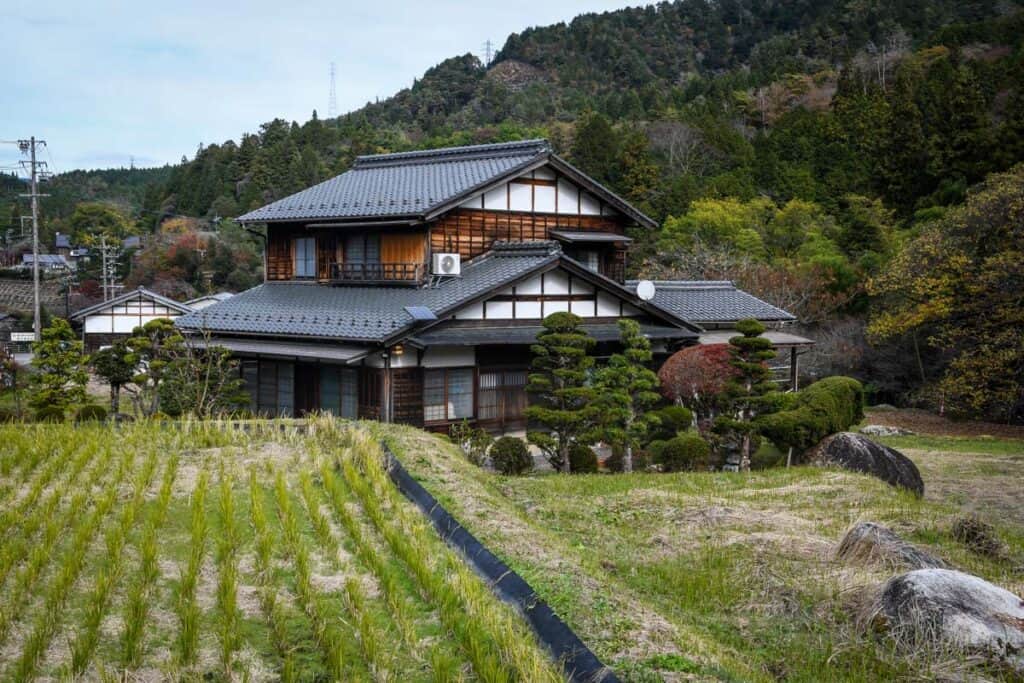
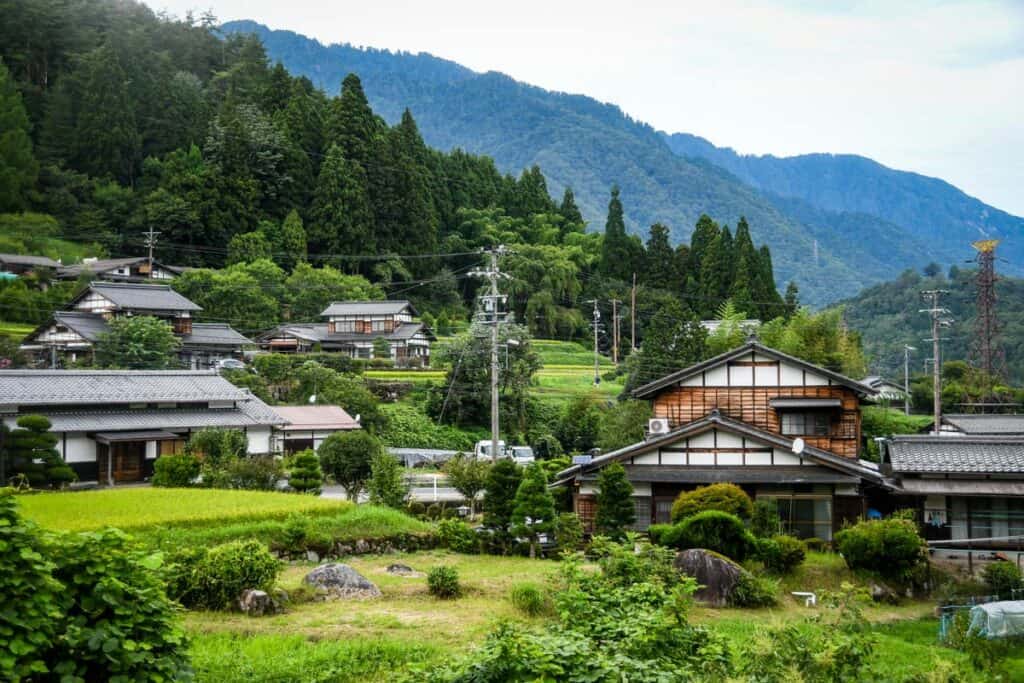
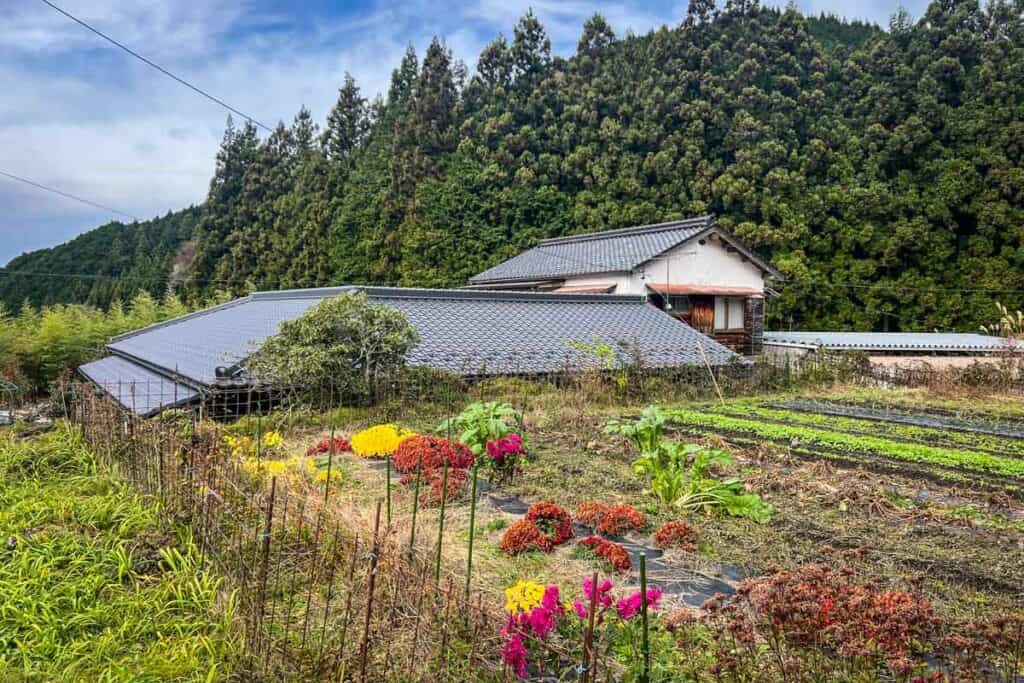
Psst! If getting off the beaten path in Japan is something that interests you, you won’t want to miss our Japan Hidden Gems Itinerary. It’s full of unique, enriching experiences that you won’t find in the tourism guidebooks.
Cobblestone path

As you get closer to Tsumago, you’ll reach a section of the Nakasendo Trail that has been preserved in its original form. The cobblestone pathway slopes gently downward, snaking through the forest around many twists and turns.
This is considered one of the most picturesque portions of the trail, and you’ll definitely want to stop for some photos!
Bear bells
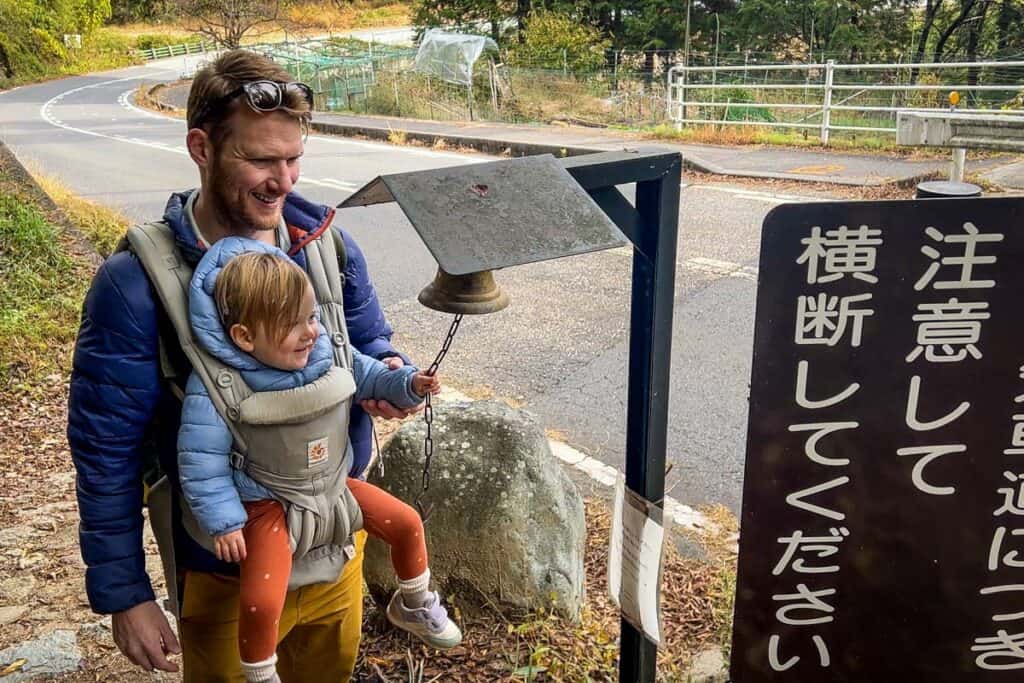
As you walk the Nakasendo Trail, you’ll come across multiple signs warning hikers of bears, some of which are posted alongside bells. The idea is to ring the bell in order to scare off any bears in the area.
We have never personally seen (or met anyone who has seen) a bear on the Nakasendo Trail. I don’t think you need to worry about it too much, and definitely don’t let it scare you away from doing this hike.
That said, this region of Japan is known to have a higher population of Asiatic black bears, so hikers are encouraged to ring the bells. That, along with some hiking chit-chat, should be enough to avoid bears, as they are scared of humans anyway.
You can even turn it into a game if you’re hiking with a child – Juniper loved finding and ringing the bear bells!
Tsumago

If you started in Magome, you’ll end your hike in Tsumago (or vice-versa). Whereas Magome is a bit more developed and slightly more touristy, Tsumago truly feels as if you’ve stepped back in time to the Edo Era.
The local council enforces rules for preservation that include hiding power lines from view, prohibiting vending machines on the main street, and maintaining certain pedestrian-only streets during the day.
To this day, Tsumago is known as one of the best-preserved feudal towns in Japan.
If you’re following our itinerary (more on that in the next section!), you’ll arrive in Tsumago around noon, giving you some time to explore and have a bite to eat. We recommend trying some of these regional snacks that Tsumago is known for:
- gohei mochi: grilled rice cake with sweet and savory walnut-miso glaze
- mitarashi dango: rice dumplings with a sweet soy glaze
- beef skewers
Nakasendo Trail itinerary
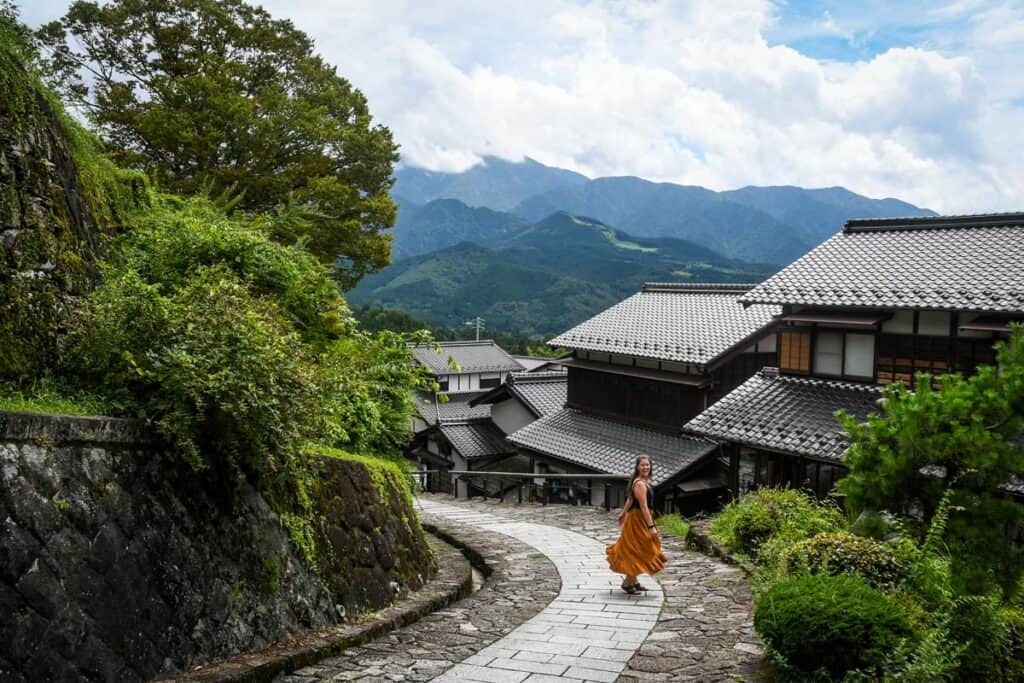
This is the exact itinerary we followed both times we walked the Nakasendo Trail. It worked really well for us and was easy to fit into our itineraries, both when exploring Japan by public transportation in 2019 and with a rental car in 2023.
Note: We personally have only stayed in Magome, but this timeline should still work if you’re staying in Tsumago and hiking the trail in reverse.
Day 1
- Arrive in Magome and check into your accommodation (jump here for places to stay)
- Explore town in the evening
- Photo tip: The water wheel right outside Magome Chaya is a great photo spot at sunset/dusk!
- Enjoy a local dinner
- Most accommodations have the option to book dinner, which we’d recommend because there aren’t many other options in town
Day 2
- Wake up early and have breakfast at your accommodation
- Check out and store your luggage (either at your hotel or in your rental car)
- Grab coffee to-go
- Your hotel likely won’t have coffee, so if you need a morning pick-me-up, HillBilly Coffee Company is the best spot in town!
- Start the hike at 9 a.m.
- Reach the teahouse that marks the halfway point around 10 a.m.
- Leave the teahouse by 11 a.m.
- Arrive in Tsumago around noon
- Have lunch in Tsumago and explore a bit if you have time
- Make your way to the bus station
- Take the bus back to Magome and retrieve your luggage
- Return Times: 12:47 p.m., 2:22 p.m., or 4:42 p.m.
- The ride takes about 30 minutes and costs ¥600 per adult
- Cash only; no notes larger than ¥1,000 are accepted
What to pack
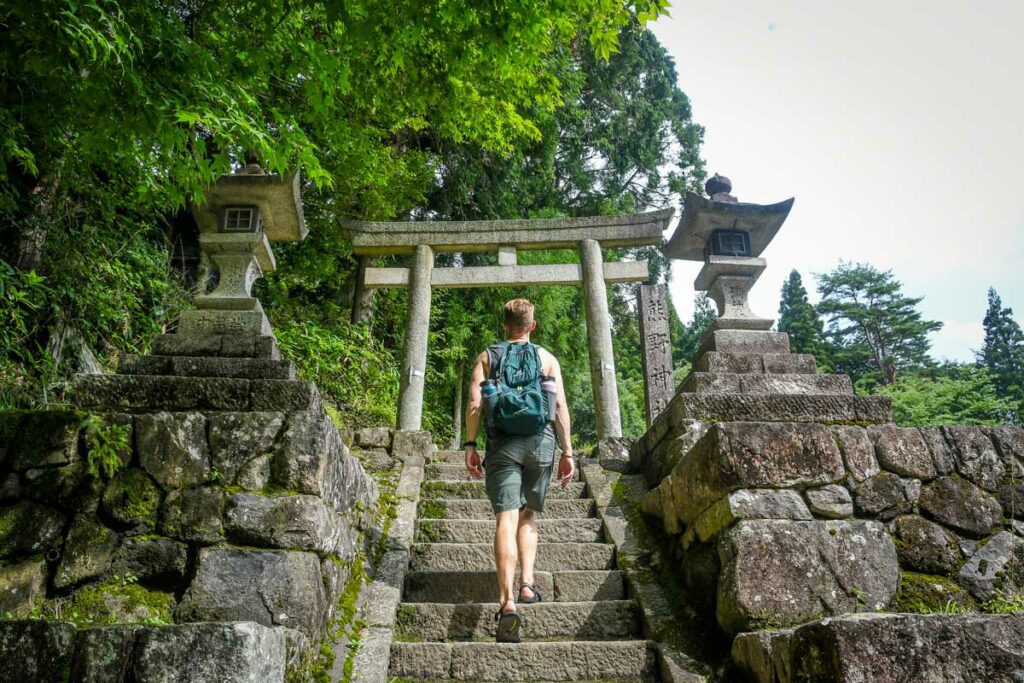
This is not a long or difficult hike, so you won’t need a ton of gear. Here are a few things you’ll definitely want to bring:
- Daypack
- Water bottle: there are a few places to buy drinks along the way, but we prefer to carry our own water so we can limit plastic waste and hydrate whenever we’re thirsty.
- Portable battery charger
- Sunscreen and sunglasses
- Cash: you’ll need cash for the bus back to Magome & if you want to make a donation at the teahouse.
→ Don’t forget to grab your FREE Japan packing list!
What to wear
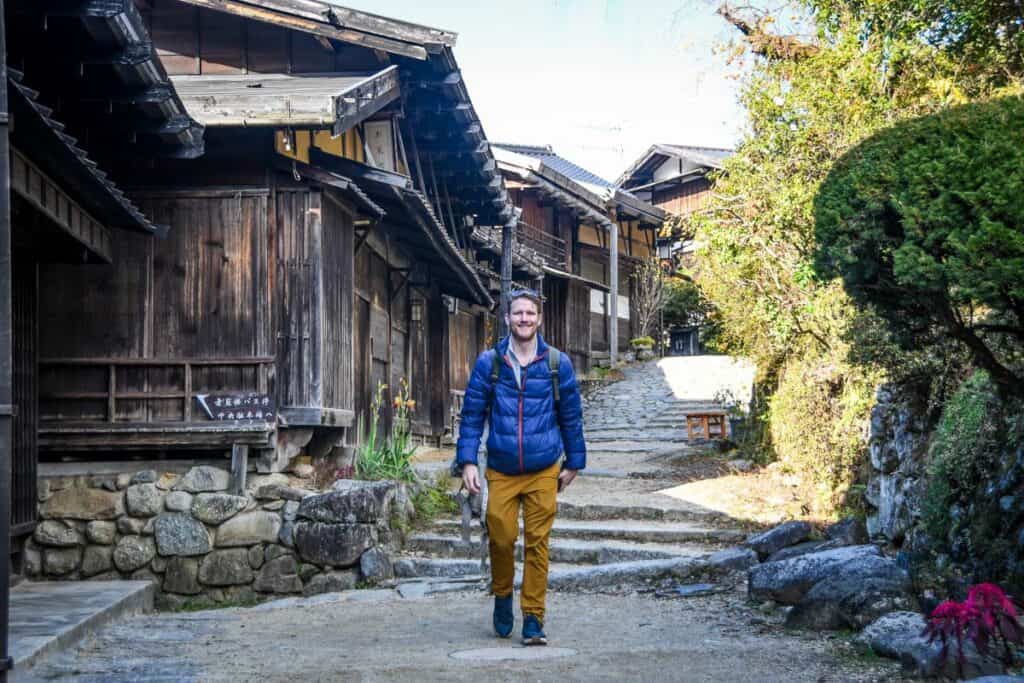
- Comfortable clothes for hiking: you don’t need anything super athletic or technical, just comfy and weather-appropriate
- Comfortable walking shoes: no need for hiking boots
- I highly recommend these shoes for Japan because they’re comfy, look nice, and are easy to slip on and off (Ben has this pair)
- When we walked the Nakasendo in summer, we wore our Chacos
- Layers
- Rain gear (jacket or umbrella), depending on the weather forecast
- Sun hat (optional)
→ Related: We have a whole article on what to wear in Japan that’s full of useful tips!
How to get there
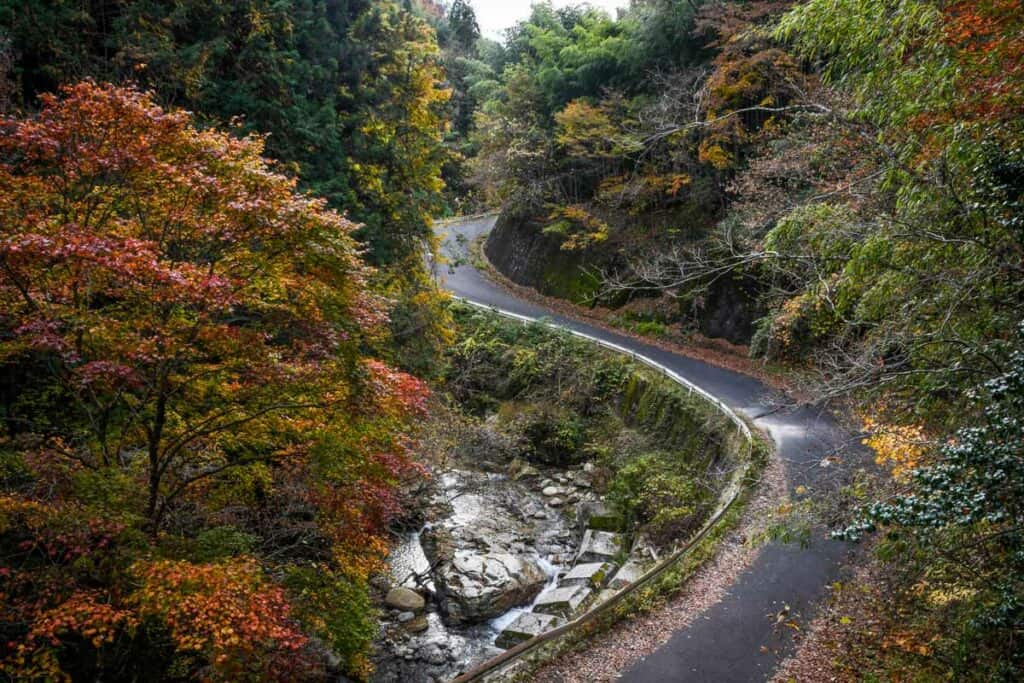
The amount of time you’ll need to budget to get to the Nakasendo Trail will depend on 3 things:
- Mode of transportation
- Where you’ll be staying (Magome or Tsumago)
- Where you’re coming from
If you’re following our Japan Hidden Gems Itinerary, you’ll be heading to Magome from Takayama, which takes roughly 2 hours driving or 5 hours by public transportation.
Public transportation
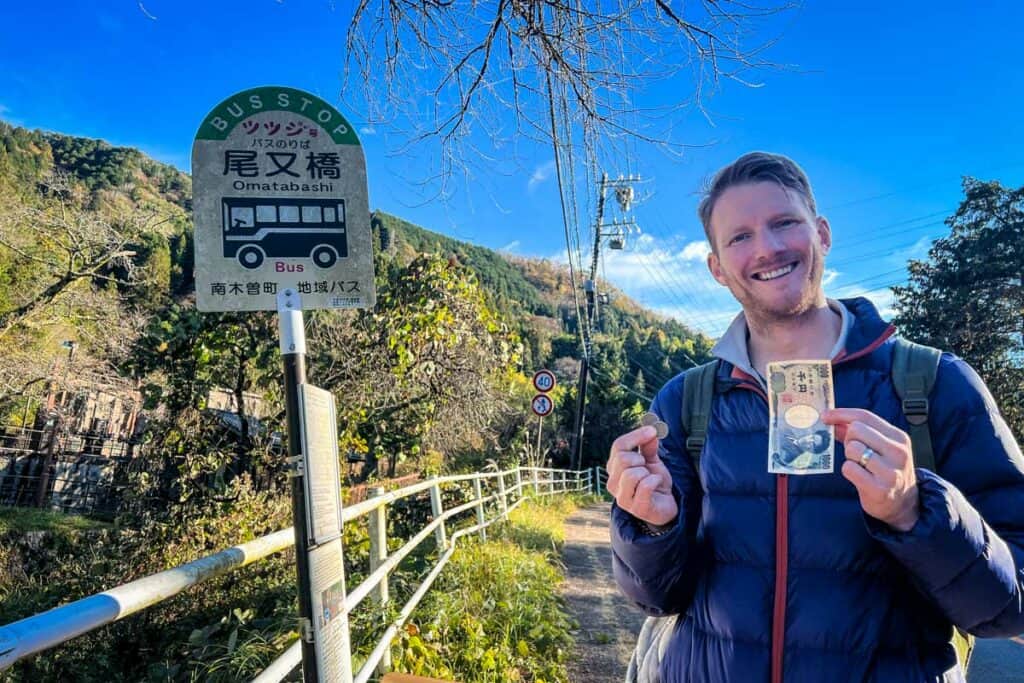
- To Magome: Make your way by train to JR Nakatsugawa Station. From there, the bus to Magome takes about 30 minutes and costs ¥570 one-way.
- To Tsumago: Take the train to Nagiso Station, then catch a bus to Tsumago (16 min, ¥300 one-way).
→ Psst! Use our Japan Rail Pass guide to determine if getting a train pass is optimal for your trip. (It could save you hundreds on transportation costs in Japan!)
Driving

Click on any of the routes below for driving directions from popular cities.
| To Magome | To Tsumago | |
|---|---|---|
| From Tokyo | Distance: 308 km / 191 miles Driving time: 4 hours View route | Distance: 280 km / 174 miles Driving time: 4 hours View route |
| From Kyoto | Distance: 216 km / 134 miles Driving time: 3 hours View route | Distance: 224 km / 139 miles Driving time: 3 hours View route |
| From Nagano | Distance: 213 km / 132 miles Driving time: 3 hours View route | Distance: 165 km / 103 miles Driving time: 2 hours 45 min View route |
→ Related: Japan Rental Car & Driving Guide
Where to stay
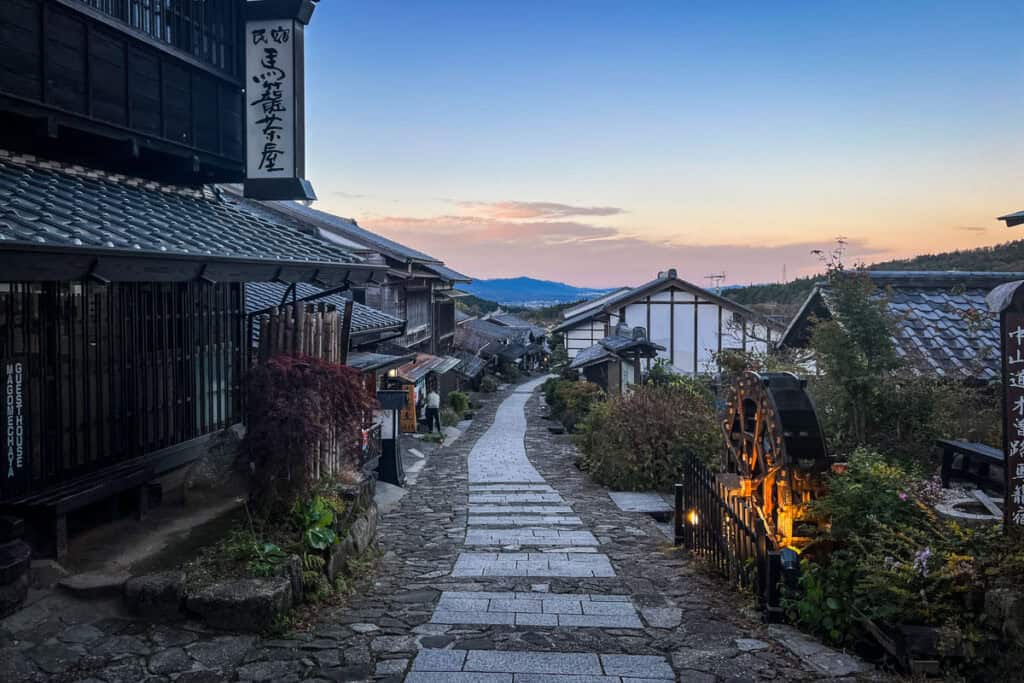
The trail brings you between Magome and Tsumago, both of which are charming towns with inns where you can stay. Which town you stay in will determine the direction in which you hike this trail.
Magome has slightly more accommodation, and in our experience has been easier to get a room.
⚠️ Important: Since Magome and Tsumago are both tiny villages with very few options, we recommend booking this stay as soon as possible (even before you book your other Japan accommodations).
Tip: If none of these properties are available, try looking for accommodation in nearby Nakatsugawa.
Places to stay in Magome
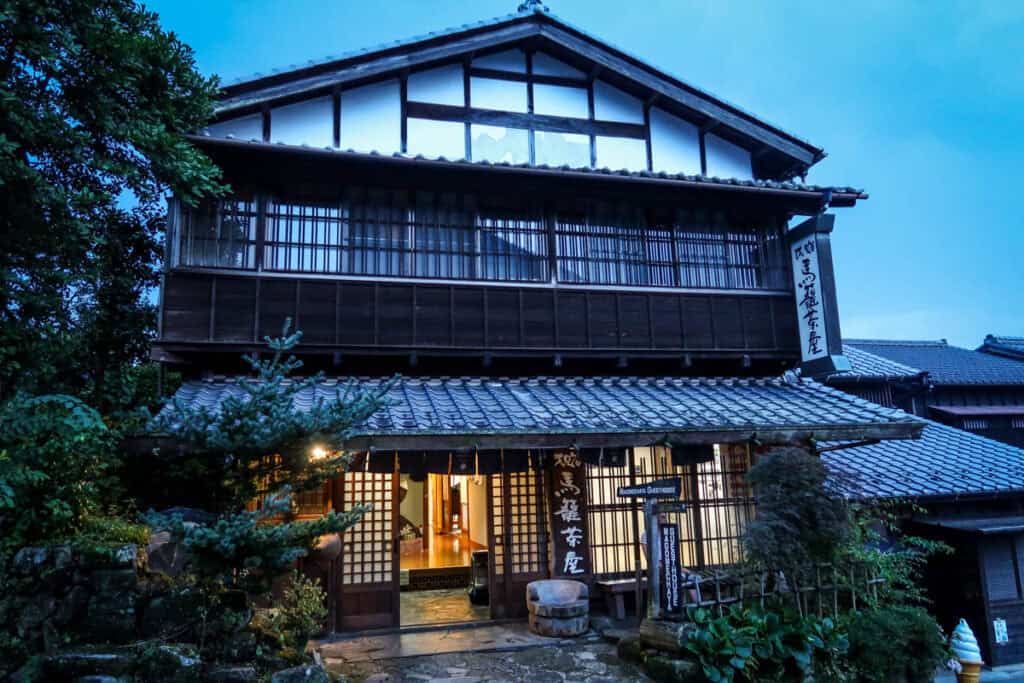
(Top rec) Magome Chaya: We personally stayed here twice, and while the rooms are basic (with a shared bathroom), you can’t beat the price or location.
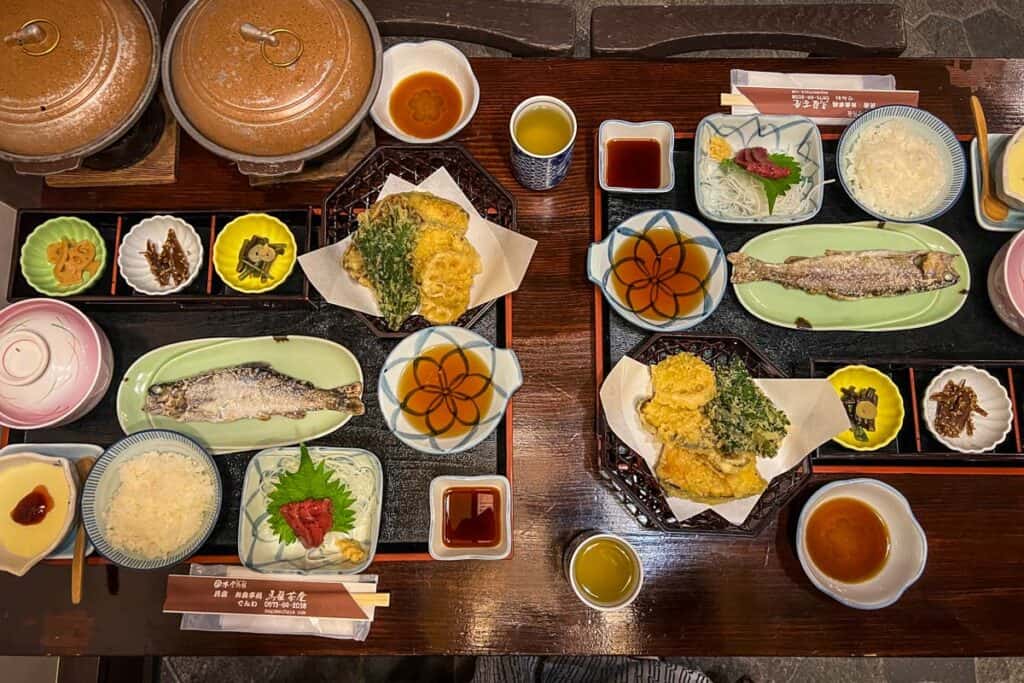

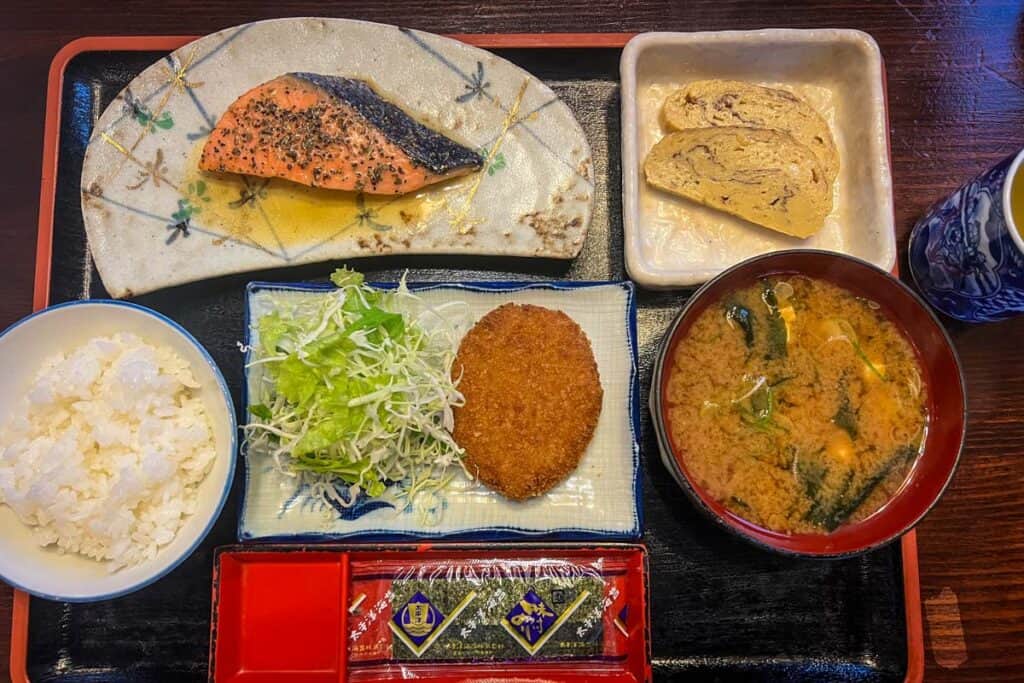
There are a variety of room types, including dorms and private rooms. You can also add meals to your stay, which we highly recommend as they offer a fantastic local dinner* and Japanese-style breakfast.
*Just a heads up that the dinner includes several dishes, one of which is horse meat sashimi (a local delicacy). They should tell you this when you sit down to eat, but we wanted to let you know in case this makes you uncomfortable.
Alternative options:
- Guest House Motomiya: Cozy house with only 3 guest rooms, shared bathrooms, fantastic dinner, and American-style breakfast (and coffee!)
- Magome Furusato Gakkou: This unique guesthouse in a renovated school offers private rooms, dorms, and family rooms, all with shared bathrooms and laundry facilities. You also have access to a shared kitchen, where you can purchase a few basic items like ramen and frozen meals.
- Guesthouse Yanagiya: A great option for groups or families, this spacious 1-bedroom apartment has 5 Japanese futon beds and a kitchen with a microwave, toaster, and kettle.
Places to stay in Tsumago
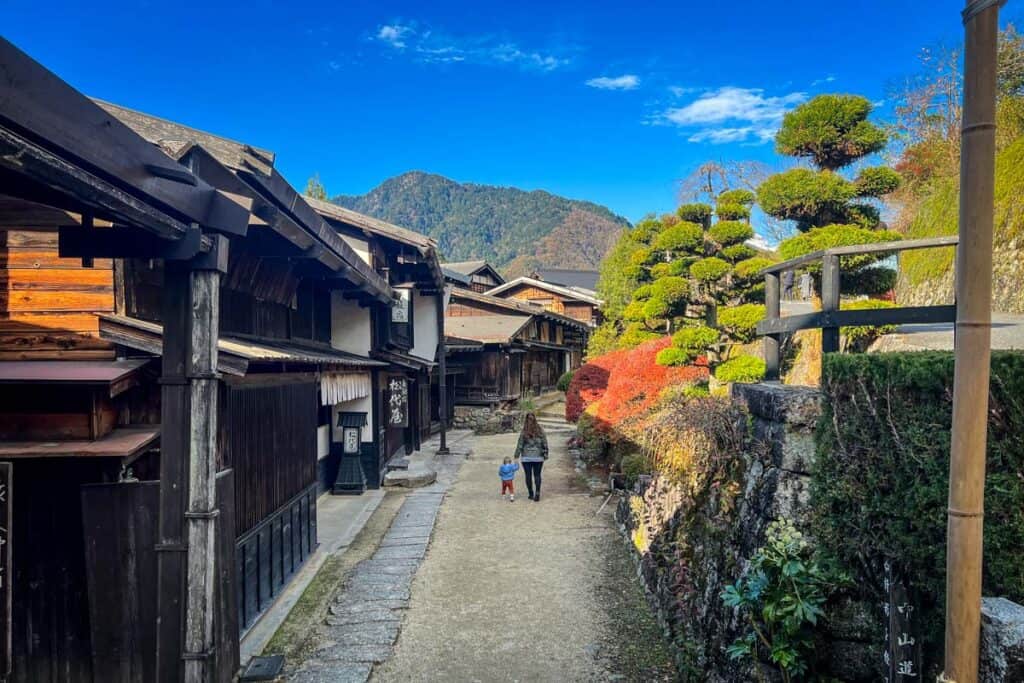
Tsumago is even smaller and more off the beaten path than Magome, which means options are extremely limited. Most accommodations here aren’t found on sites like Booking.com or Expedia, and some may need to be reserved by phone.
- Daikichi: This 5-bedroom inn receives rave reviews. You can choose to include breakfast and/or dinner with your stay (we highly recommend doing this!), or pay only for the room. Request a reservation on their website.
- Matsushiroya Ryokan: This 200-year-old ryokan is a unique accommodation for guests who want a true cultural experience. The rooms purposely lack modern amenities like TVs and clocks in order to preserve the inn’s historic charm, and traditional breakfast and dinner are available to add to your stay.
- Reservations for this guest house must be made by phone.
Note: The rooms at this Matsushiroya Ryokan are separated by sliding doors. If you’re worried about noise or disturbing other guests, this may not be the best choice for you.
Food on the Nakasendo Trail
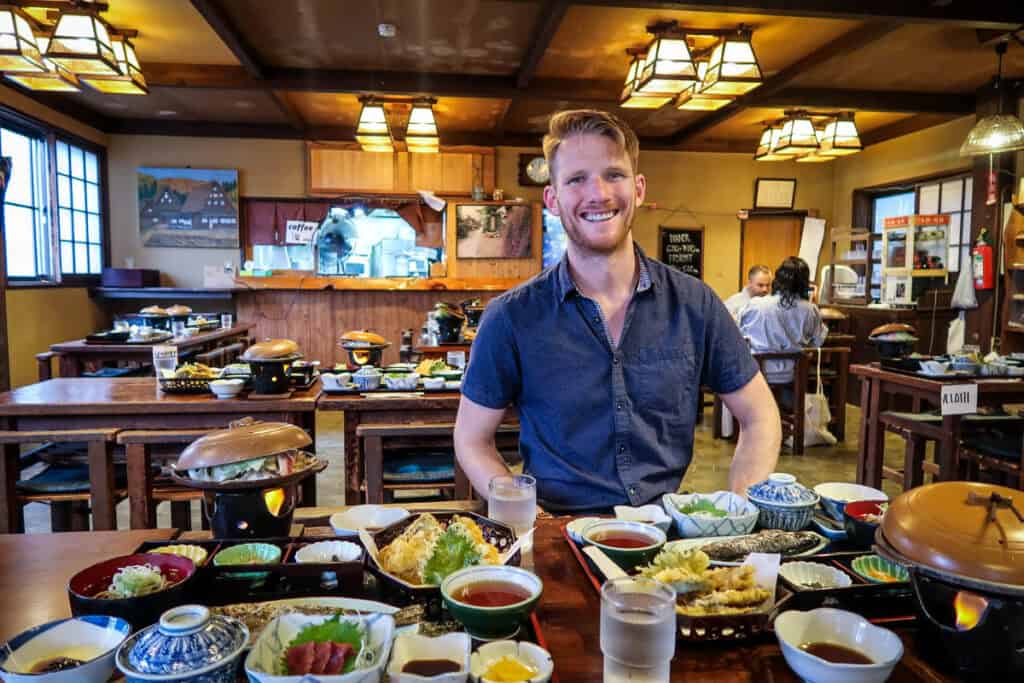
Though it isn’t a long or strenuous hike, we suggest bringing a few snacks and plenty of water for the Nakasendo Trail.
Whether you decide to stay in Magome or Tsumago, we strongly recommend booking dinner at your accommodation because there aren’t many options in either town. Most accommodations have an add-on option for dinner; if not, they should be able to help you book dinner elsewhere.
Places to eat in Magome

- HillBilly Coffee Company: your hotel likely won’t have coffee, so if you need a morning pick-me-up, this is the best spot in town!
- Haginoya: kaiseki restaurant open for dinner
- Ontaya: dinner only
- Magome also has a handful of soba noodle shops that are open for lunch and close around 2-4 p.m.
Places to eat in Tsumago
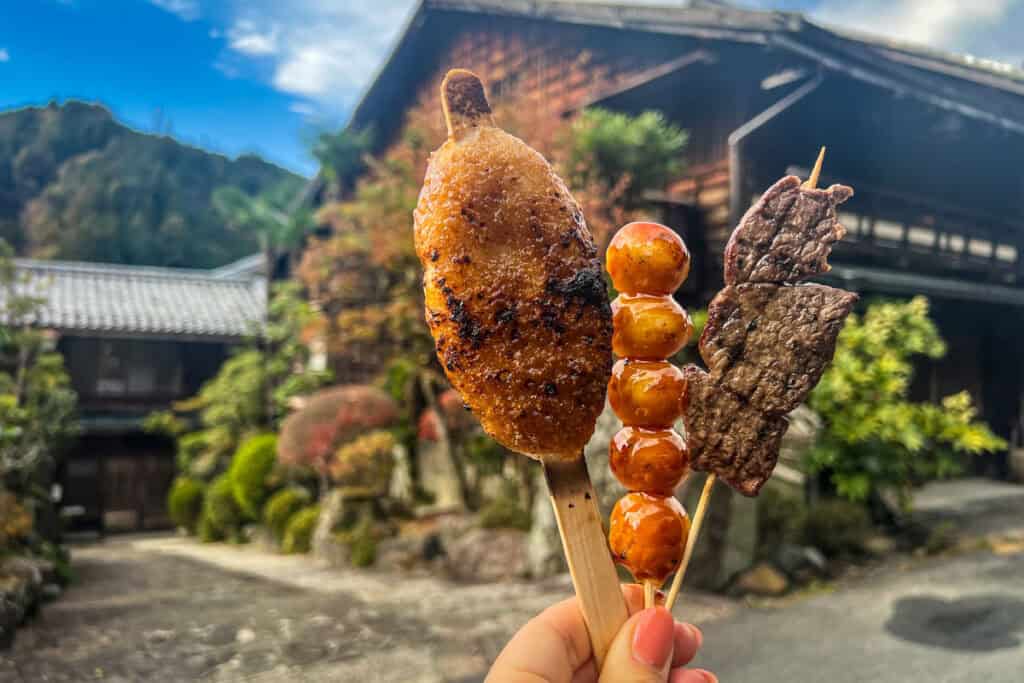
- Konohanaya: small place to get some regional snacks with a koi pond and garden at the back of the cafe
- Suzuya: Seasonal ice cream (chestnut while we were there)
- Good Day Coffee & Bar (Kojitsu Coffee): coffee, ice cream, and food
- Yamagiri Shokudo: Syokudo and Teishoku restaurant open until 5 p.m. (closed Tuesdays)
- Ebiya: cafe opens at 8:30 a.m. so you can get coffee here if you stay in Tsumago (closed Tuesdays)
- This ramen restaurant has good reviews and is open until 2:30 p.m.
Nakasendo Trail FAQs
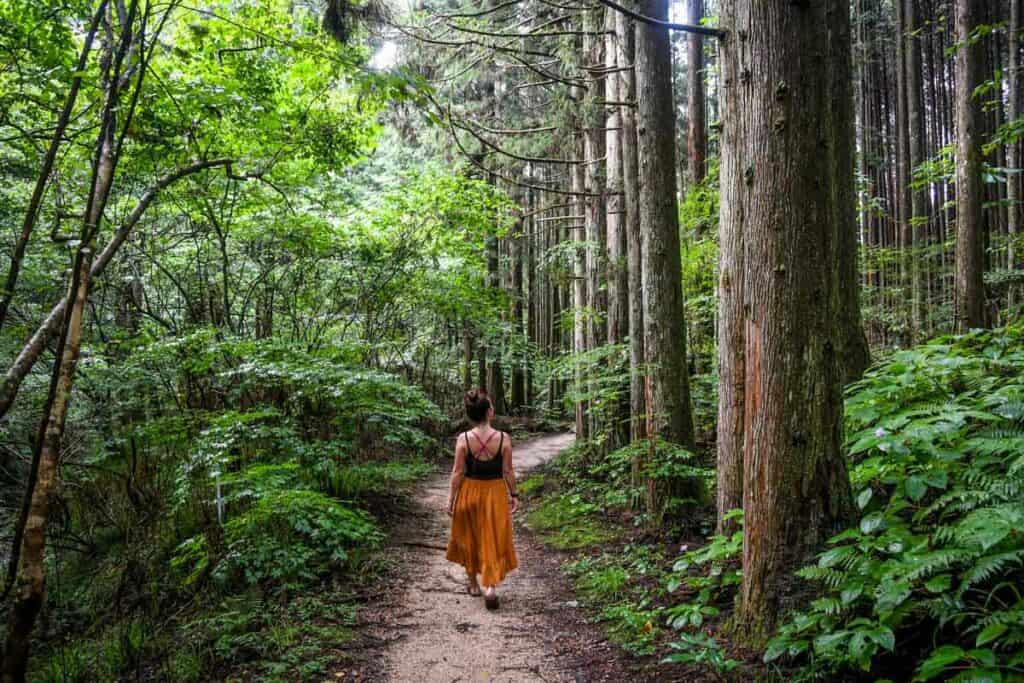
Still have questions about hiking the Nakasendo Trail? We have answers!
How difficult is the trail?
The trail itself is pretty easy and there’s not much elevation gain.
It took us about 4 hours at a leisurely pace with lots of time for photos, a stop at the teahouse, and letting a toddler walk for a bit. You could do it much faster if you wanted.
Are there bathrooms on the trail?
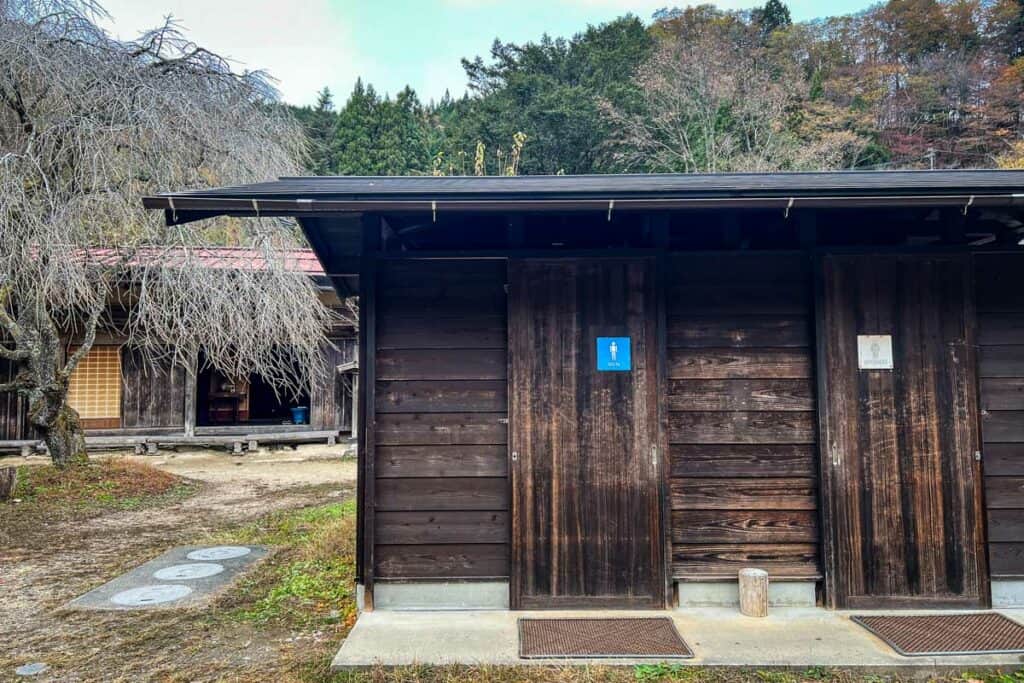
The only public restrooms on the trail are at the teahouse marking the halfway point.
Is it crowded?
Take this with a grain of salt, as this was our personal experience and maybe we just got lucky—but the Nakasendo Trail is one of the less-touristy things we’ve done in Japan.
Between our visits to Japan in 2015, 2019, and 2023, we’ve seen a noticeable increase in crowds at popular tourist sites, like Fushimi Inari Shrine and Nara Deer Park.
But the Nakasendo Trail was an exception.
Even on a beautiful fall day in November 2023, we saw very few other people on the trail and actually had it to ourselves most of the time.
Can I hike the Nakasendo Trail with children?
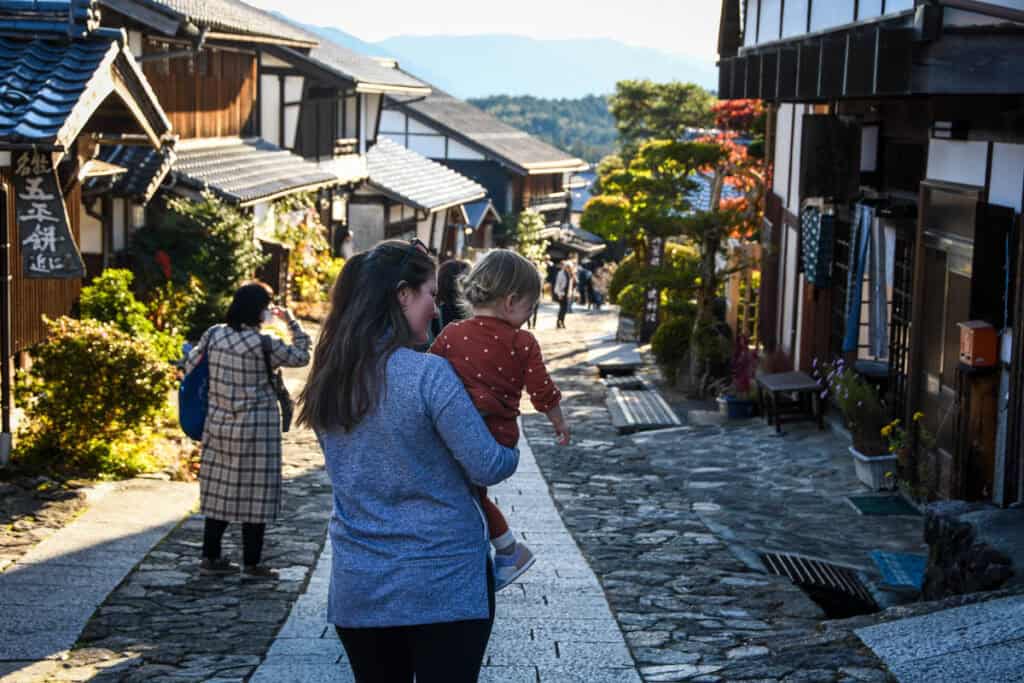
Absolutely!
I guess I should clarify and say that it depends on your child(ren) and your comfort level; but yes, it is certainly possible.
We did this hike with a 2-year-old and had a great experience. She was at an age where we carried her most of the time, which certainly helped. (We used our Ergo Baby 360 for this hike.)
She even napped in the carrier during the hike then woke up right before we reached Tsumago, so we really lucked out! (We do lots of hiking with her at home and on trips, so she’s used to this type of thing.)
If she were a little older, I think we would have needed to budget a bit more time because as she’s gotten older she wants to walk more on her own (which is slower than when we carry her!).
Older kids (that are used to long walks) will love this trail as it’s not too difficult and there is lots of varying scenery and things to look at along the way.
Do I need to stay overnight?
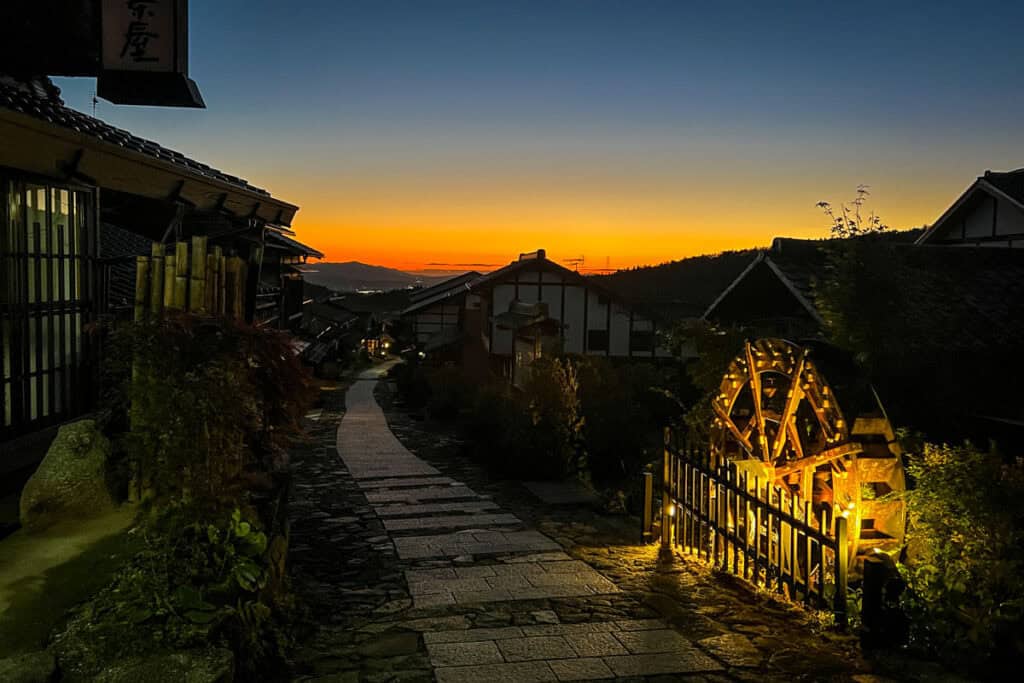
Yes, you should definitely spend at least one night in either Magome or Tsumago. While there may be a possibility that you could arrive in the morning, hike, then depart in the afternoon, we wouldn’t recommend it.
For one, the towns on the Nakasendo Trail are absolutely magical and so worth spending the night. And secondly, staying overnight will give you the time you need to not feel rushed and to fully enjoy this experience.
Should I stay the night before or the night after?
We’ve done this trail twice and both times, it worked out better logistically to spend the night before setting off on the trail. That way, you can get an early start and you can store your luggage at your hotel until you return.
What if it rains?
Depending on what time of year you do this hike, rain is a real possibility. The first time we hiked the Nakasendo Trail (in August 2019), it started pouring rain right before we got to the teahouse, so we were able to take shelter for a bit and have a hot cup of tea.
As long as you’re prepared for the weather, you should be fine. Bring a rain jacket and/or umbrella and wear shoes with decent grip because some parts of the trail may be a bit slippery.
Plan your trip to Japan
After 3 trips (and counting!), we’ve fallen head over heels for Japan—and we’ve created TONS of resources to help you plan your dream trip. Start with our Ultimate Japan Travel Guide and be sure to check out these helpful articles:
- First time? Our Japan Trip Planner walks you through everything you need to know.
- Use our Japan Rail Pass guide to determine if getting a train pass is optimal for your trip.
- Here’s our curated list of the best things to do in Japan—from iconic sights to once-in-a-lifetime experiences.
- Not sure where to go? Our Japan itinerary ideas will help you map it all out.
- Foodies, rejoice! This guide to what to eat in Japan will have you drooling before you land.
- This guide to what to wear in Japan (and what not to wear) will help you blend in.
- Use our ultimate Japan Packing List to make sure you don’t forget anything.
- Before you go, brush up on these essential Japan travel tips (including major do’s and don’ts!).
- Avoid awkward moments by brushing up on Japanese etiquette.
Still have questions? Drop us a comment—we LOVE helping travelers plan unforgettable trips to Japan!
Perfect Japan itinerary
Want the perfect itinerary planned for you?

If you don’t have a ton of time to spend planning your Japan itinerary (or you just don’t find travel planning fun), we’ve got something you might be interested in…
We created the ultimate done-for-you Japan itinerary that is packed full of all sorts of tips we’ve gathered from 3 trips to Japan as well as literally hundreds of hours of research (no exaggeration).
We have both an off-the-beaten path route as well as a classic itinerary that hits the top attractions (perfect for your first visit to Japan!).
Don’t miss your chance to grab this freebie!
This FREE PDF download includes everything you’re going to want to pack for your Japan trip, including what NOT to bring, plus tons of insider tips!
Just enter your email and we’ll immediately send you access instructions!
Save this article on Pinterest for later!
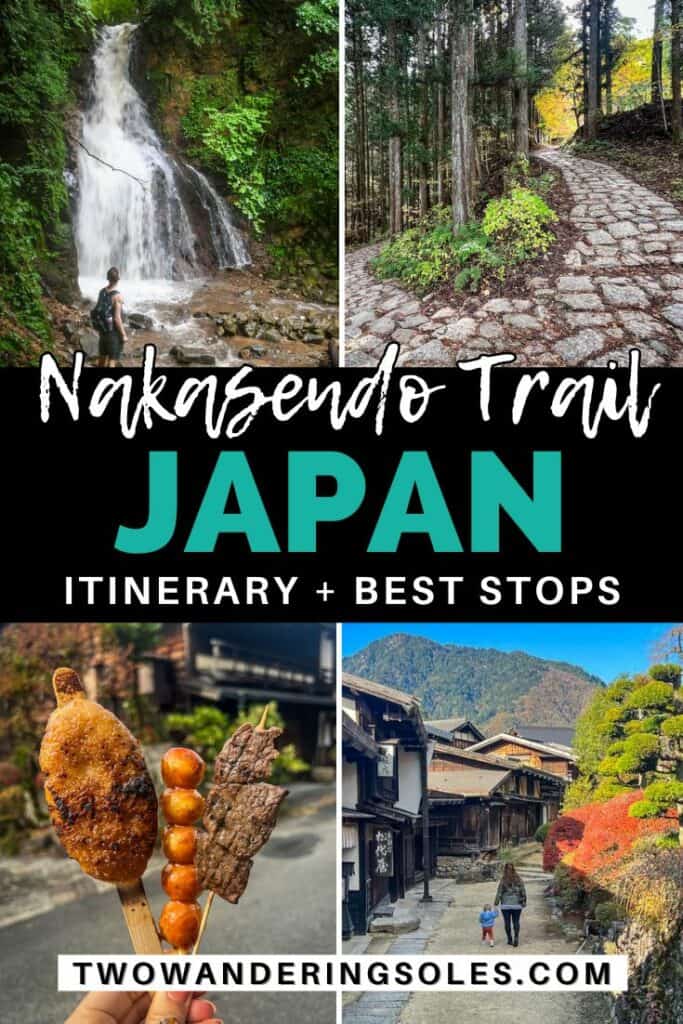
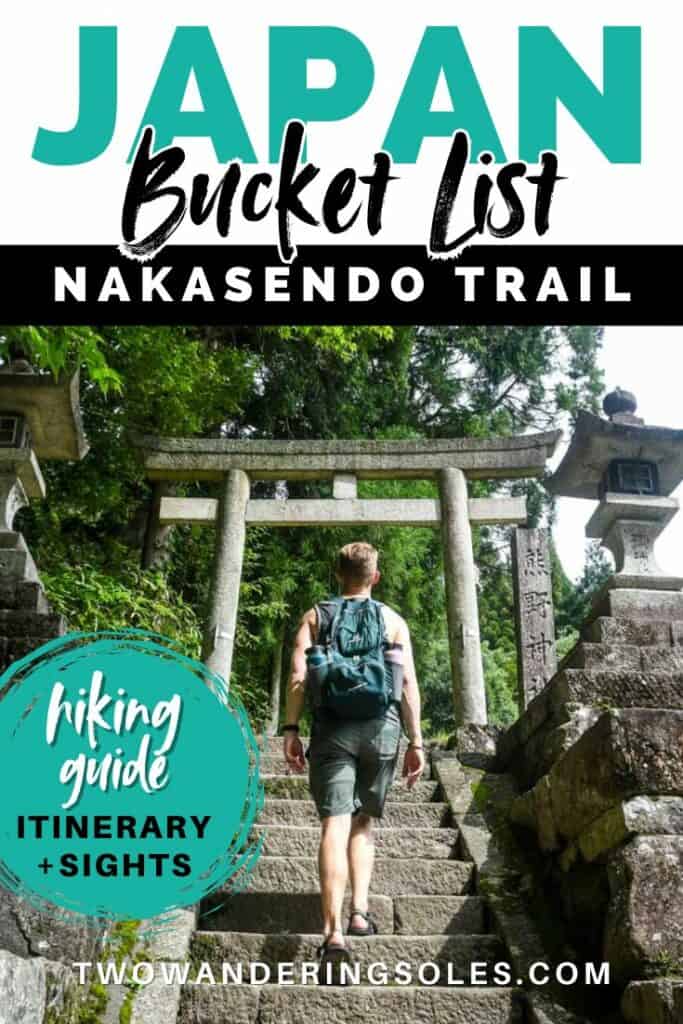
We want to hear from you!
Are you planning to hike the Nakasendo Trail in Japan and still have questions? Leave your comment below and we’ll do our best to get back to you!

